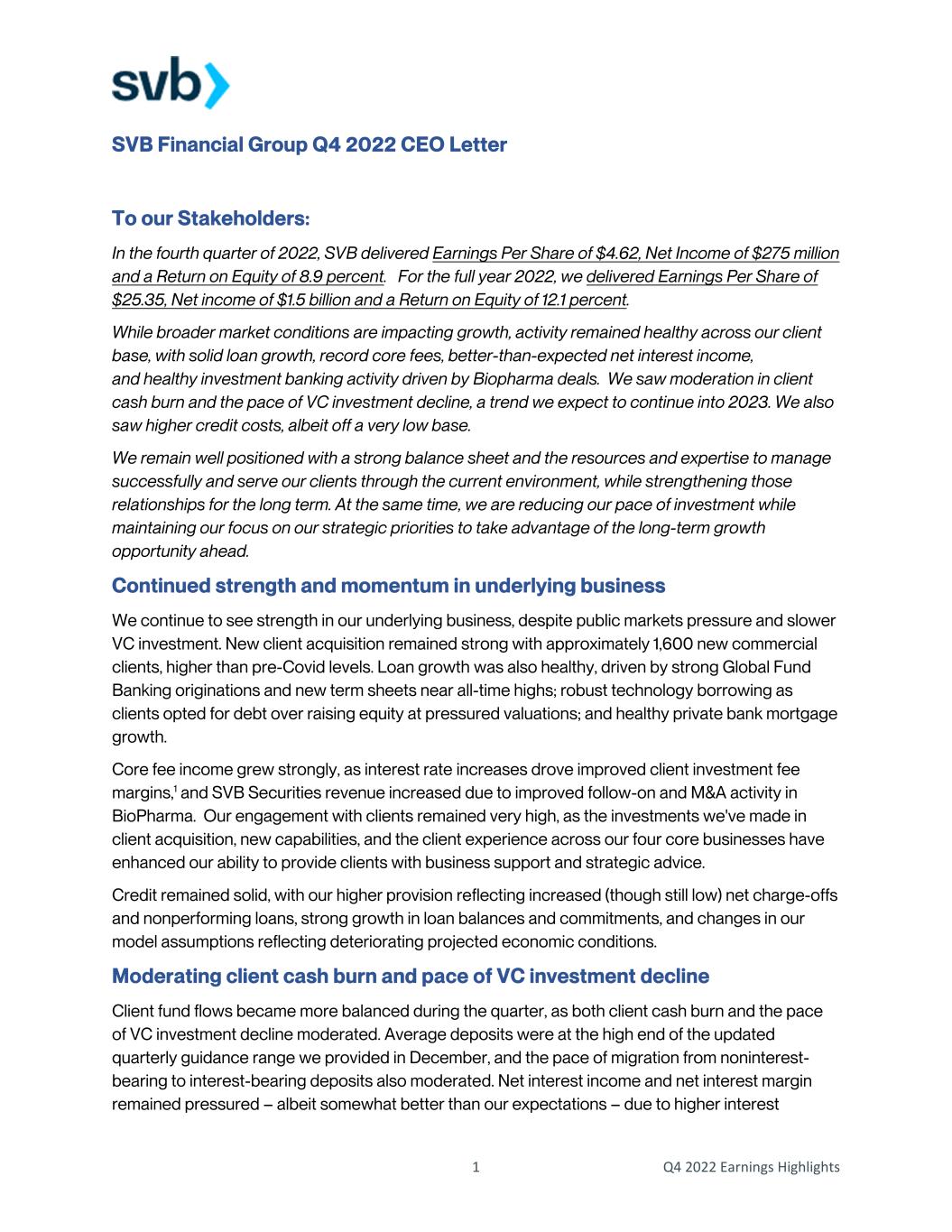
1 Q4 2022 Earnings Highlights SVB Financial Group Q4 2022 CEO Letter To our Stakeholders: In the fourth quarter of 2022, SVB delivered Earnings Per Share of $4.62, Net Income of $275 million and a Return on Equity of 8.9 percent. For the full year 2022, we delivered Earnings Per Share of $25.35, Net income of $1.5 billion and a Return on Equity of 12.1 percent. While broader market conditions are impacting growth, activity remained healthy across our client base, with solid loan growth, record core fees, better-than-expected net interest income, and healthy investment banking activity driven by Biopharma deals. We saw moderation in client cash burn and the pace of VC investment decline, a trend we expect to continue into 2023. We also saw higher credit costs, albeit off a very low base. We remain well positioned with a strong balance sheet and the resources and expertise to manage successfully and serve our clients through the current environment, while strengthening those relationships for the long term. At the same time, we are reducing our pace of investment while maintaining our focus on our strategic priorities to take advantage of the long-term growth opportunity ahead. Continued strength and momentum in underlying business We continue to see strength in our underlying business, despite public markets pressure and slower VC investment. New client acquisition remained strong with approximately 1,600 new commercial clients, higher than pre-Covid levels. Loan growth was also healthy, driven by strong Global Fund Banking originations and new term sheets near all-time highs; robust technology borrowing as clients opted for debt over raising equity at pressured valuations; and healthy private bank mortgage growth. Core fee income grew strongly, as interest rate increases drove improved client investment fee margins,1 and SVB Securities revenue increased due to improved follow-on and M&A activity in BioPharma. Our engagement with clients remained very high, as the investments we've made in client acquisition, new capabilities, and the client experience across our four core businesses have enhanced our ability to provide clients with business support and strategic advice. Credit remained solid, with our higher provision reflecting increased (though still low) net charge-offs and nonperforming loans, strong growth in loan balances and commitments, and changes in our model assumptions reflecting deteriorating projected economic conditions. Moderating client cash burn and pace of VC investment decline Client fund flows became more balanced during the quarter, as both client cash burn and the pace of VC investment decline moderated. Average deposits were at the high end of the updated quarterly guidance range we provided in December, and the pace of migration from noninterest- bearing to interest-bearing deposits also moderated. Net interest income and net interest margin remained pressured – albeit somewhat better than our expectations – due to higher interest

2 Q4 2022 Earnings Highlights expense as a result of client cash burn shifting our funding mix, our continued success leveraging our flexible liquidity solutions to support deposit growth, and client preferences for higher rates in the current environment. These initial signs of moderation are encouraging. We have seen four consecutive quarters of declining VC investment, but the pace of decline appears to be slowing. US VC investment dollars, at $238 billion – while 30 percent lower than 2021 – were higher than in any other year.2 In the near-term, we expect VC investment to remain pressured, but should see the balance of client fund flows improve as clients continue to reduce cash burn. We expect the mix shift from noninterest-bearing to interest-bearing deposits to continue to slow throughout the year, and believe we will end 2023 with a sustainable level of noninterest-bearing deposits in the high 30% range. This anticipated slowing shift in deposit mix will be foundational for earnings stability and growth as we exit 2023. We require additional and sustained improvement in the balance between VC deployment and cash burn for deposits to grow, but we do not need to see VC funding return to 2021 levels. We believe that each quarter brings us a step closer to the point at which VCs and entrepreneurs find common ground on valuations and the massive amount of dry powder waiting to be deployed is unlocked. 2023 outlook In light of continued uncertainty over interest rates, inflation, and the broader economy, we have more limited visibility into our full-year performance than usual. While we are providing full-year 2023 guidance, for now we are also providing guidance for the first quarter of 2023 to offer additional color on our expectations. Our full-year outlook is summarized below, and specifics on our first quarter expectations are provided in our Q4’22 Financial Highlights presentation. We see 2023 as a transitional year, one in which we expect to manage through the challenges of the higher rate environment and continued market volatility, while plotting our course back to growth and more normal levels of profitability. We believe continued public and private market pressures will result in lower 2023 deposits, net interest income and net interest margin; and will continue to impact the more market-sensitive parts of our business. We expect these market pressures to moderate throughout the year and clients to continue to reduce cash burn in the slower funding environment. We expect an eventual stabilization in the level of noninterest-bearing deposits and a return to modest deposit growth in 2H’23 to provide an inflection point for NII and NIM in the second half of the year. This shift, along with progressive paydowns in our investment securities portfolio, should provide meaningful revenue tailwinds that will build with each passing quarter in later 2023 and into 2024. We expect loans to grow, as corporate clients turn to borrowing in lieu of equity, our strong GFB pipeline converts to new originations, and our private banking business offers mortgage lending to individuals affiliated with our commercial clients. We expect healthy credit performance overall, although persistent market pressures will likely increase credit losses and non-performing loans from their current historic lows. Consistent with our

3 Q4 2022 Earnings Highlights experience, we expect losses to be concentrated in the early-stage investor dependent portfolio, which is currently only 3 percent of total loans, although we could see higher non-performing loans among our later-stage, larger technology and healthcare borrowers. We will continue to invest for the long term, leveraging our progress on our strategic priorities of the past two years to refine and refocus spending on revenue-producing initiatives; integration across the commercial bank, investment bank and private bank; and continued risk management enhancements across the business. At the same time, we are taking advantage of opportunities to optimize our spending: for example, slowing the pace of professional services spend and reducing our reliance on contractors. These actions will allow us to keep investing in our key strategic priorities in 2023 while reducing the overall pace of expense growth. Strong and well positioned We remain well-positioned to support our clients and navigate current market conditions. We have a high-quality, liquid balance sheet; strong capital ratios; and multiple levers to manage liquidity. The investments we’ve made in our four core businesses over time have significantly expanded our capabilities, diversified our revenues, and enhanced our ability to serve our clients. Our innovation clients, in general, have stronger balance sheets and better business models than in past cycles, and a long history of resilience through market cycles. SVB’s strength and staying power enables us to lean in with our clients at times like these and help them to work through their challenges, strengthening our relationships and planting the seeds for future growth. Our proven leadership team has long track record of navigating successfully through market cycles, and we have made several recent appointments that further fortify our leadership abilities. In December, we appointed Erin Platts President of SVB Private and a member of the Executive Committee. Erin has been with SVB for more than 18 years and was instrumental in growing our UK and EMEA businesses, leading the successful incorporation of SVB UK as a standalone bank and subsidiary. Erin will be responsible for driving SVB Private’s strategy to meet the unique personal financial needs of the entrepreneurs, founders and investors behind the innovation economy. We tapped David Sabow to take over as CEO of SVB UK and Head of EMEA. David has been with SVB for 10 years, most recently as the Head of Technology and Healthcare Banking, a role in which he successfully integrated two distinct groups and delivered record business growth across both verticals. David will lead and develop SVB’s commercial banking business across Germany, the UK, Nordics, Ireland and Israel. Both Erin’s and David’s appointments are pending regulatory approval. We also brought new talent into key roles. Laura Cushing joined us in October as Chief Human Resources Officer, replacing our longtime CHRO, Chris Edmonds-Waters, who is transitioning to a new role in the organization. Laura is a seasoned professional with extensive experience in talent management, organizational development and leading cultural transformations for global organizations. She will play a key role in enabling us to continue to grow our business and develop our workforce with an emphasis on our values.
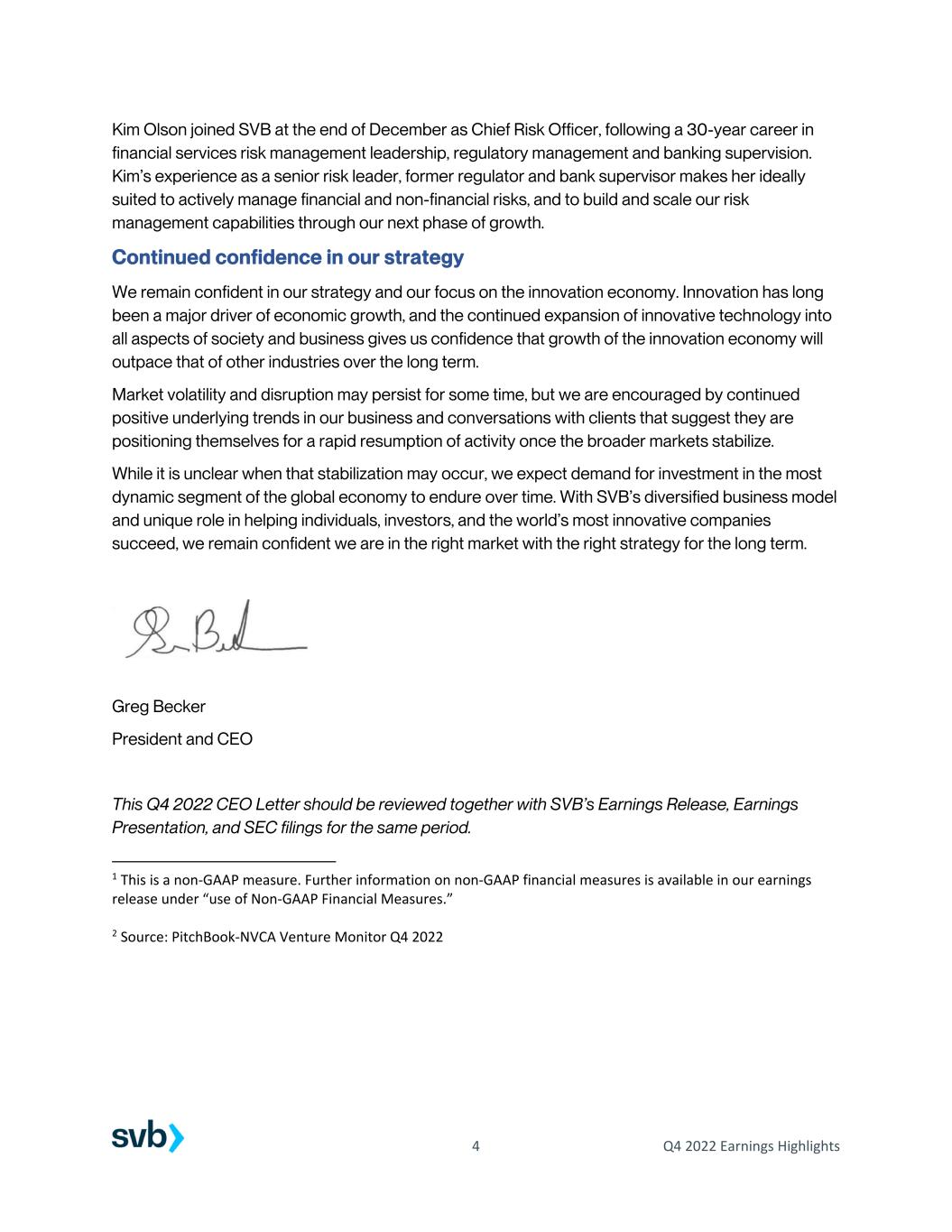
4 Q4 2022 Earnings Highlights Kim Olson joined SVB at the end of December as Chief Risk Officer, following a 30-year career in financial services risk management leadership, regulatory management and banking supervision. Kim’s experience as a senior risk leader, former regulator and bank supervisor makes her ideally suited to actively manage financial and non-financial risks, and to build and scale our risk management capabilities through our next phase of growth. Continued confidence in our strategy We remain confident in our strategy and our focus on the innovation economy. Innovation has long been a major driver of economic growth, and the continued expansion of innovative technology into all aspects of society and business gives us confidence that growth of the innovation economy will outpace that of other industries over the long term. Market volatility and disruption may persist for some time, but we are encouraged by continued positive underlying trends in our business and conversations with clients that suggest they are positioning themselves for a rapid resumption of activity once the broader markets stabilize. While it is unclear when that stabilization may occur, we expect demand for investment in the most dynamic segment of the global economy to endure over time. With SVB’s diversified business model and unique role in helping individuals, investors, and the world’s most innovative companies succeed, we remain confident we are in the right market with the right strategy for the long term. Greg Becker President and CEO This Q4 2022 CEO Letter should be reviewed together with SVB’s Earnings Release, Earnings Presentation, and SEC filings for the same period. 1 This is a non‐GAAP measure. Further information on non‐GAAP financial measures is available in our earnings release under “use of Non‐GAAP Financial Measures.” 2 Source: PitchBook‐NVCA Venture Monitor Q4 2022

Q4 2022 Financial Highlights January 19, 2023

3 Snapshot and current environment 23 Performance detail and outlook drivers 36 Appendix 49 Non-GAAP reconciliations This presentation should be reviewed with our Q4 2022 Earnings Release and Q4 2022 CEO Letter, as well as the company’s SEC filings. Contents Q4 2022 FINANCIAL HIGHLIGHTS 2

Snapshot and current environment Q4 2022 FINANCIAL HIGHLIGHTS 3
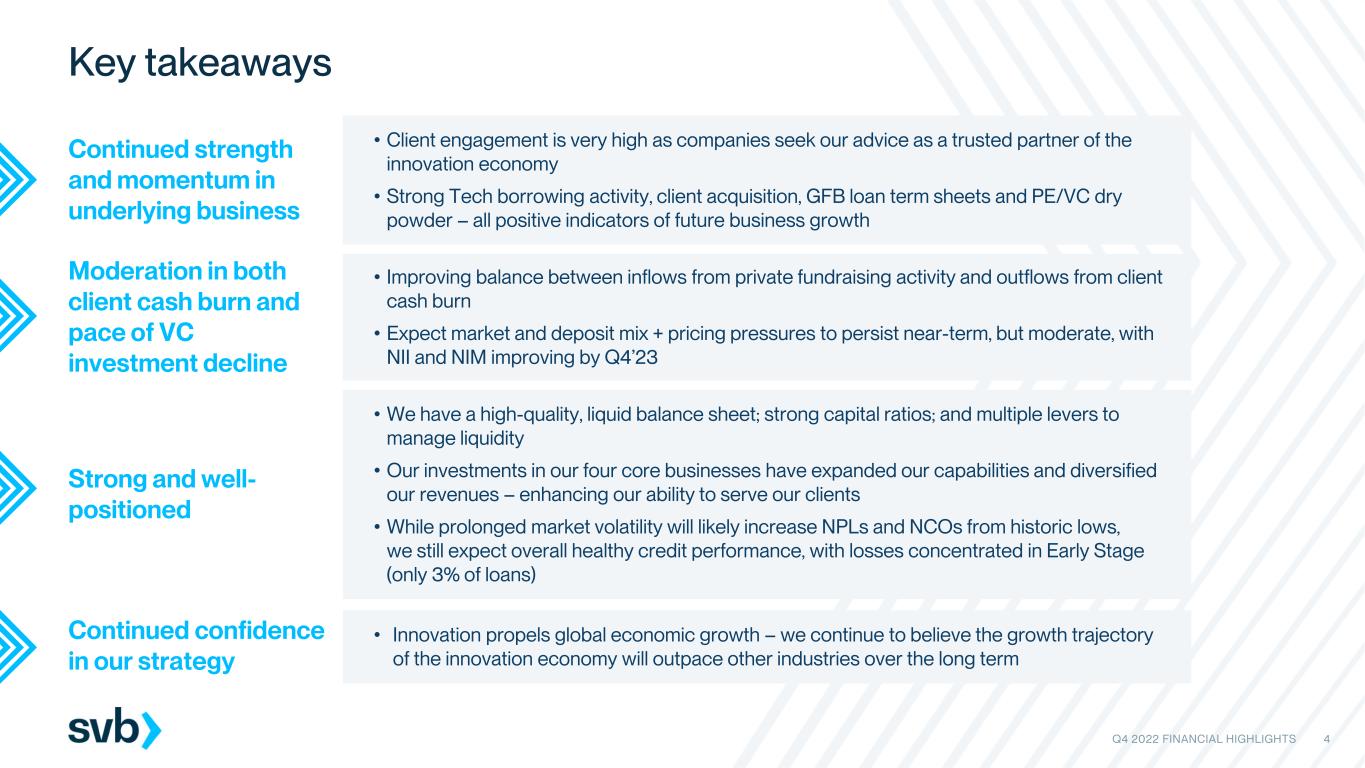
Key takeaways Moderation in both client cash burn and pace of VC investment decline Strong and well- positioned Continued strength and momentum in underlying business Continued confidence in our strategy • Innovation propels global economic growth – we continue to believe the growth trajectory of the innovation economy will outpace other industries over the long term • Client engagement is very high as companies seek our advice as a trusted partner of the innovation economy • Strong Tech borrowing activity, client acquisition, GFB loan term sheets and PE/VC dry powder – all positive indicators of future business growth • Improving balance between inflows from private fundraising activity and outflows from client cash burn • Expect market and deposit mix + pricing pressures to persist near-term, but moderate, with NII and NIM improving by Q4’23 • We have a high-quality, liquid balance sheet; strong capital ratios; and multiple levers to manage liquidity • Our investments in our four core businesses have expanded our capabilities and diversified our revenues – enhancing our ability to serve our clients • While prolonged market volatility will likely increase NPLs and NCOs from historic lows, we still expect overall healthy credit performance, with losses concentrated in Early Stage (only 3% of loans) Q4 2022 FINANCIAL HIGHLIGHTS 4

1. Net interest income presented on a fully taxable equivalent basis. 2. Non-GAAP financial measure. See “Use of non-GAAP Financial Measures” in our Q4 2022 Earnings Release and our non-GAAP reconciliations at the end of this presentation. 3. Represents investment banking revenue and commissions. 4. Includes $27M pre-tax investment losses on sale of $1B AFS US Treasury securities. 5. Related to acquisition of Boston Private. Q4’22 snapshot: Continued pressure from market challenges, but underlying business activity remained strong; both client cash burn and pace of VC investment decline moderated Financial highlights Q4’22 performance +/– changes are vs. Q3’22 $152M +$53M, +54% SVB Securities revenue2, 3 $74B +$3B, +4% Average loans $348B -$21B, -6% Average client funds $175B Deposits, -$11B, -6% $173B OBS, -$10B, -5% $141M +$69M, +96% Provision for credit losses (driven by increased NPLs and NCOs, growth, and model assumptions) $1.0B -$160M, -13% Net interest income1 EPS: $4.62* ROE: 8.9% Net Income: $275M $349M +$33M, +10% Core fee income2 ($49M) -$13M, -36% Warrant gains and investment losses net of NCI2, 4 *includes –$0.15 impact from Q4 2022 FINANCIAL HIGHLIGHTS 5 $11M Pre-tax merger-related charges5 $341B -$12B, -3% EOP client funds $173B Deposits, -$4B, -2% $168B OBS, -$8B, -5% 19.1% -8.1% Effective Tax Rate (driven by state tax and R&D credits)
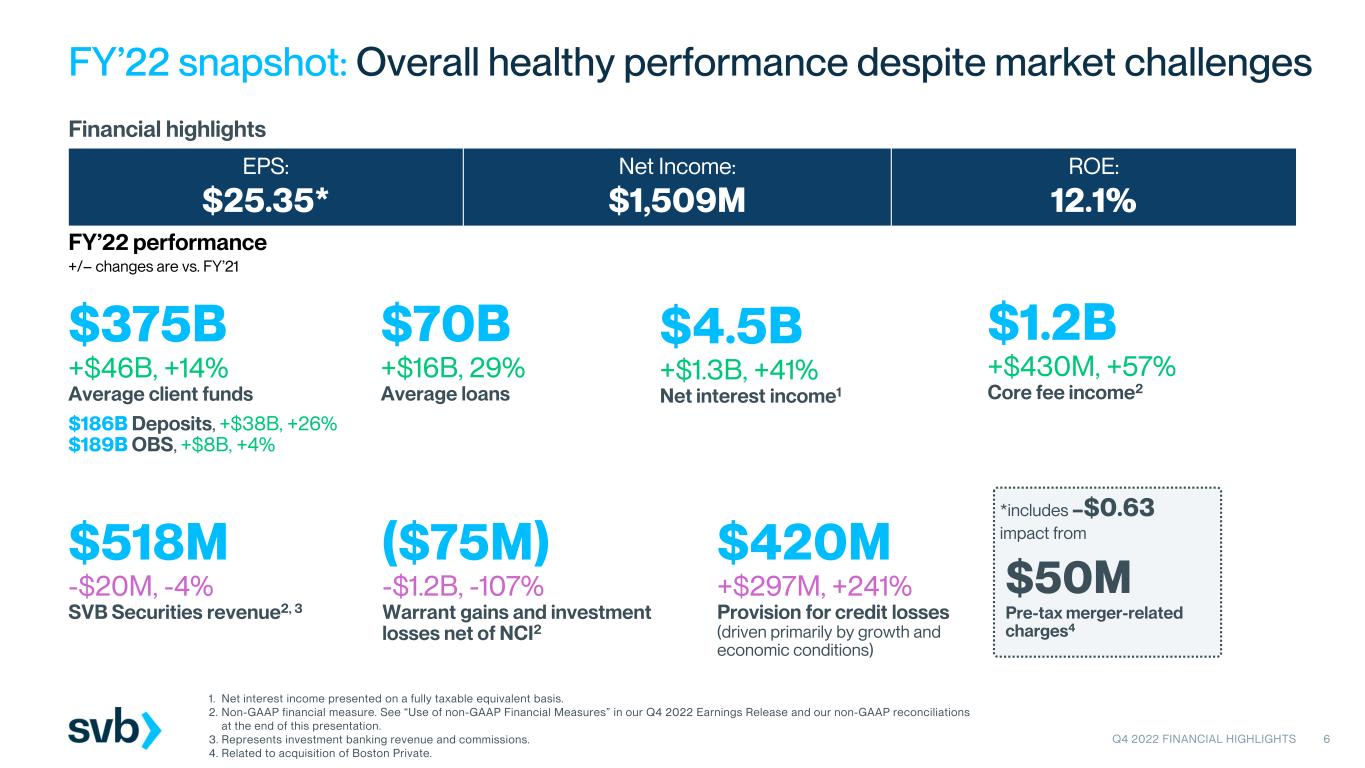
1. Net interest income presented on a fully taxable equivalent basis. 2. Non-GAAP financial measure. See “Use of non-GAAP Financial Measures” in our Q4 2022 Earnings Release and our non-GAAP reconciliations at the end of this presentation. 3. Represents investment banking revenue and commissions. 4. Related to acquisition of Boston Private. Q4 2022 FINANCIAL HIGHLIGHTS 6 FY’22 snapshot: Overall healthy performance despite market challenges $518M -$20M, -4% SVB Securities revenue2, 3 $70B +$16B, 29% Average loans $420M +$297M, +241% Provision for credit losses (driven primarily by growth and economic conditions) $4.5B +$1.3B, +41% Net interest income1 $1.2B +$430M, +57% Core fee income2 ($75M) -$1.2B, -107% Warrant gains and investment losses net of NCI2 *includes –$0.63 impact from $50M Pre-tax merger-related charges4 $375B +$46B, +14% Average client funds $186B Deposits, +$38B, +26% $189B OBS, +$8B, +4% EPS: $25.35* ROE: 12.1% Net Income: $1,509M Financial highlights FY’22 performance +/– changes are vs. FY’21

516 642 603 751 1,181 2018 2019 2020 2021 2022 Record core fee income Core fee income2 $M Q4 2022 FINANCIAL HIGHLIGHTS 7 Continued strength and momentum in underlying business 1. Source: Preqin. As of January 3, 2023. 2. Non-GAAP financial measure. See “Use of non-GAAP Financial Measures” in our Q4 2022 Earnings Release and our non-GAAP reconciliations at the end of this presentation. 3. Non-performing loans as a percentage of period-end total loans. 4. Net loan charge-offs as a percentage of average total loans. 0 5,000 10,000 15,000 20,000 25,000 30,000 35,000 40,000 2018 2019 2020 2021 2022 Other PE/VC VC-Backed Pre-VC-backed Strong new client growth ~1,600 in Q4’22 SVB commercial client count 26 30 37 55 70 2018 2019 2020 2021 2022 20.6% 20.0% 16.8% 17.1% 12.1% 2018 2019 2020 2021 2022 Healthy profitability ROE 34 32 23 14 18 22 24 20 21 10 2018 2019 2020 2021 2022 NPLs NCOs 1,257 1,364 1,651 1,669 2,000 220 260 324 377 558 1,477 1,623 1,975 2,046 2,558 2018 2019 2020 2021 2022 VC PE Record PE/VC dry powder Global PE/VC dry powder1 $B Near record GFB loan term sheets and strong Tech, LS/HC borrowing activity Average loans $B Healthy credit metrics NPLs and NCOs Bps 3 4
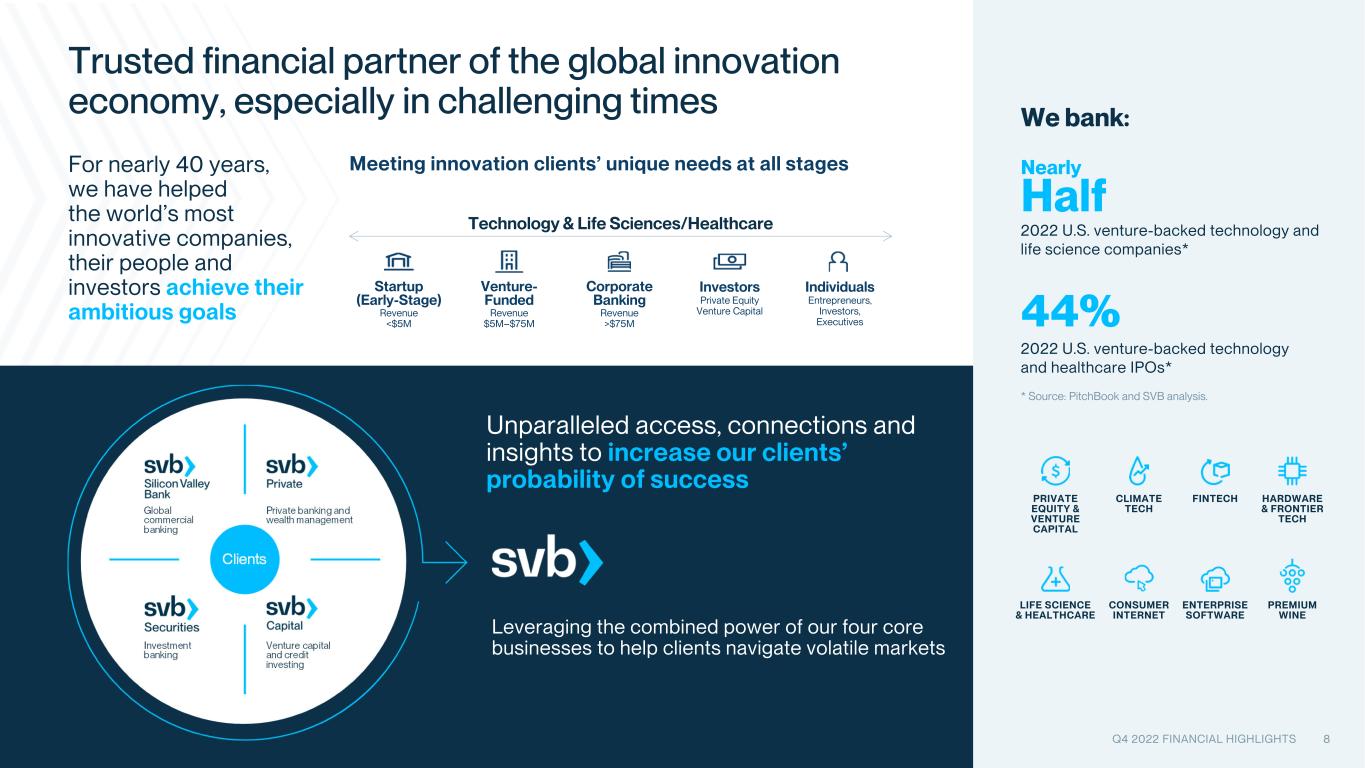
Technology & Life Sciences/Healthcare Corporate Banking Revenue >$75M Startup (Early-Stage) Revenue <$5M Venture- Funded Revenue $5M–$75M Investors Private Equity Venture Capital Individuals Entrepreneurs, Investors, Executives ENTERPRISE SOFTWARE CONSUMER INTERNET LIFE SCIENCE & HEALTHCARE PREMIUM WINE PRIVATE EQUITY & VENTURE CAPITAL HARDWARE & FRONTIER TECH FINTECHCLIMATE TECH 2022 U.S. venture-backed technology and life science companies* Nearly Half 2022 U.S. venture-backed technology and healthcare IPOs* We bank: For nearly 40 years, we have helped the world’s most innovative companies, their people and investors achieve their ambitious goals Leveraging the combined power of our four core businesses to help clients navigate volatile markets Unparalleled access, connections and insights to increase our clients’ probability of success Global commercial banking Investment banking Private banking and wealth management Venture capital and credit investing Clients * Source: PitchBook and SVB analysis. Trusted financial partner of the global innovation economy, especially in challenging times Meeting innovation clients’ unique needs at all stages 44% Q4 2022 FINANCIAL HIGHLIGHTS 8

Q4’22 highlights 1. Improved balance between VC investment and client cash burn, moderating EOP client fund declines QoQ 2. Lower NII and NIM despite higher loan yields as growth in proportion of interest-bearing deposits and average borrowings pressured interest expense; premium amortization expense also increased 3. Higher provision balanced across increased NCOs and NPLs, strong growth and model assumptions; still expect overall healthy credit performance, with losses concentrated in Early Stage 4. Investment losses driven by private fund investment markdowns and sale of $1.0B AFS securities 5. Healthy loan growth driven by GFB capital call, Technology and Private Bank mortgage borrowing 6. Record core fee income* as Fed rate hikes drove improved client investment fee margin 7. Outperformed SVB Securities revenue* outlook on strong Biopharma deal activity – higher than expected expenses reflect related incentives and deferred compensation costs 8. Lower effective tax rate (in Q4 only) driven by state tax and R&D credits 9. Continued, but moderating, market challenges to pressure FY’23 growth; reducing pace of investment to reflect current environment, but remain optimistic in the long-term opportunity of the innovation economy * Non-GAAP financial measure. See “Use of non-GAAP Financial Measures” in our Q4 2022 Earnings Release and our non-GAAP reconciliations at the end of this presentation. Q4 2022 FINANCIAL HIGHLIGHTS 9

41 37 38 34 39 38 49 46 79 83 89 94 80 75 47 36 - 20 40 60 80 100 Q1'19 Q2'19 Q3'19 Q4'19 Q1'20 Q2'20 Q3'20 Q4'20 Q1'21 Q2'21 Q3'21 Q4'21 Q1'22 Q2'22 Q3'22 Q4'22 1. VC data sourced from PitchBook. Investment data has been updated with PitchBook’s proprietary back-end data set and filters which has resulted in prior period revisions. 2. Determination of TCF changes by client activity is an illustrative approximation based on management assumptions and analysis of SVB client and PitchBook data; assumes each client's total change in period-end balances is attributed to one of the following activities: fundraising, other inflows or outflows. QoQ period-end total client funds (“TCF”) by client activity (management’s approximation)2 $B QoQ period-end TCF change (+/-) U.S. VC-backed investment activity1 $B Improved balance between VC deployment and client cash burn Q4 2022 FINANCIAL HIGHLIGHTS 10 Q1’19 Q2’19 Q3’19 Q4’19 Q1’20 Q2’20 Q3’20 Q4’20 Q1’21 Q2’21 Q3’21 Q4’21 Q1’22 Q2’22 Q3’22 Q4’22 Q1’19 Q2’19 Q3’19 Q4’19 Q1’20 Q2’20 Q3’20 Q4’20 Q1’21 Q2’21 Q3’21 Q4’21 Q1’22 Q2’22 Q3’22 Q4’22 Slowing VC deployment continued to reduce client fund inflows in Q4’22, but at a more moderate pace • QoQ U.S. VC investment declined 23% in Q4’22 vs. 37% in Q3’22 5.2 6.6 8.9 4.9 7.9 21.7 21.1 31.5 45.0 41.0 42.4 27.9 -1.9 -18.2 -25.5 -12.2 (160.0) (150.0) (140.0) (130.0) (120.0) (110.0) (100.0) (90.0) (80.0) (70.0) (60.0) (50.0) (40.0) (30.0) (20.0) (10.0) - 10.0 20.0 30.0 40.0 50.0 60.0 70.0 Client cash burn decreased, helping limit period-end declines • Client cash burn remains ~2x higher than pre-2021 levels and still has room to adjust to the slower fundraising environment2 We expect client funds growth will resume when VC investment improves and client cash burn normalizes, even if VC investment does not return to 2021 levels Outflows (primarily cash burn) Private fundraising Public fundraising Other inflows (primarily operating inflows)

22% 30%23% 13% 3% 8% 1% 30% 21% 9%3% 18% 13% 6% Leveraging flexible liquidity solutions 40+ Total client funds by client niche1 Early stage life science/ healthcare Early stage technology Private Bank International2 Life science/ healthcare Technology Other U.S. Global Fund Banking Note: All figures as of December 31, 2022 unless otherwise noted. 1. Represents management view of client niches. 2. International balances do not represent foreign exposure as disclosed in regulatory reports. Includes clients across all client niches and life stages, with International Global Fund Banking representing 3% of total client funds. 3. Based on deposit rates and total deposit balances at December 31, 2022. 1.50% 12/31/22 weighted average spot deposit rate (total deposits)3 Off-balance sheet sweep funds $173B Deposits $168B OBS 24% 27%26% 19% 4% ~70% Expected through- the-cycle interest- bearing deposit beta High 30s % Estimated Q4’23 noninterest-bearing share of total deposits Robust client funds franchise, with flexibility to shift liquidity on- or off-balance sheet • Clients’ operating cash typically held in on-balance sheet noninterest-bearing deposits • Clients’ excess liquidity generally held in on-balance sheet interest- bearing deposits or off-balance sheet client funds • Flexible liquidity solutions enable us to shift client funds on- or off- balance sheet $341B TCF Noninterest-bearing deposits Interest-bearing deposits Actions to support deposits are pressuring deposit beta and mix Leveraging flexible liquidity solutions that allow us to allocate funds on- or off- balance sheet When client fund growth returns, these flexible liquidity solutions can help us optimize our deposit rates and mix by shifting higher-cost deposits off-balance sheet Off-balance sheet managed funds Off-balance sheet repo funds liquidity management products to meet clients’ needs 47% 12/31/22 noninterest- bearing share of total deposits 63% 2022 interest-bearing deposit beta Q4 2022 FINANCIAL HIGHLIGHTS 11
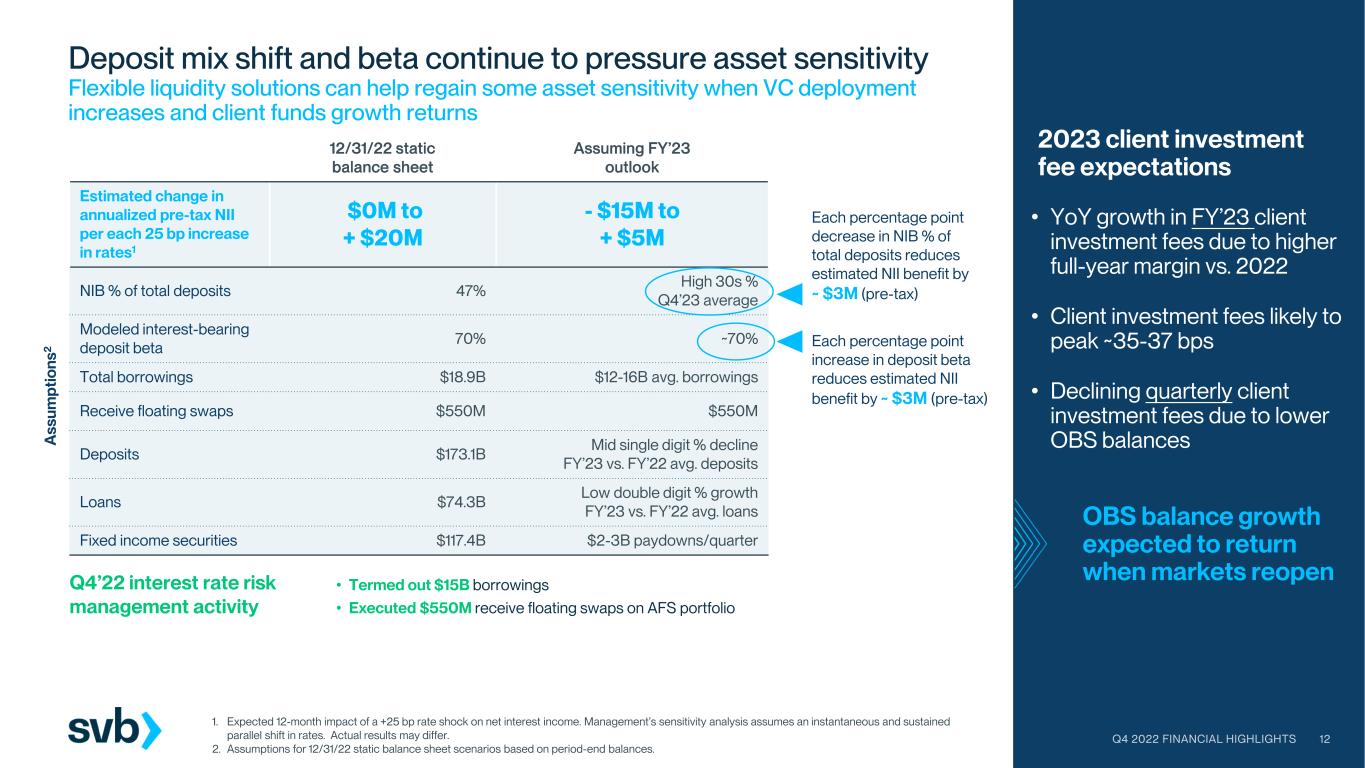
12/31/22 static balance sheet Assuming FY’23 outlook Estimated change in annualized pre-tax NII per each 25 bp increase in rates1 $0M to + $20M - $15M to + $5M NIB % of total deposits 47% High 30s % Q4’23 average Modeled interest-bearing deposit beta 70% ~70% Total borrowings $18.9B $12-16B avg. borrowings Receive floating swaps $550M $550M Deposits $173.1B Mid single digit % decline FY’23 vs. FY’22 avg. deposits Loans $74.3B Low double digit % growth FY’23 vs. FY’22 avg. loans Fixed income securities $117.4B $2-3B paydowns/quarter Deposit mix shift and beta continue to pressure asset sensitivity Flexible liquidity solutions can help regain some asset sensitivity when VC deployment increases and client funds growth returns 1. Expected 12-month impact of a +25 bp rate shock on net interest income. Management’s sensitivity analysis assumes an instantaneous and sustained parallel shift in rates. Actual results may differ. 2. Assumptions for 12/31/22 static balance sheet scenarios based on period-end balances. Each percentage point increase in deposit beta reduces estimated NII benefit by ~ $3M (pre-tax) • Termed out $15B borrowings • Executed $550M receive floating swaps on AFS portfolio Q4’22 interest rate risk management activity A s s u m p ti o n s 2 • YoY growth in FY’23 client investment fees due to higher full-year margin vs. 2022 • Client investment fees likely to peak ~35-37 bps • Declining quarterly client investment fees due to lower OBS balances OBS balance growth expected to return when markets reopen Each percentage point decrease in NIB % of total deposits reduces estimated NII benefit by ~ $3M (pre-tax) Q4 2022 FINANCIAL HIGHLIGHTS 12 2023 client investment fee expectations

Continued market uncertainty: Expect continued, but moderating, market challenges in 2023 Outlook considerations • Continued market uncertainty presents forecasting challenges – providing Q1’23 expectations to supplement FY’23 outlook2 • Current market pressures will likely persist, but moderate, impacting FY’23 growth • Expect improving balance between inflows from private fundraising activity and outflows from client cash burn as clients reduce spending • Expect near-term NII and NIM pressure as proportion of interest-bearing deposits and deposit rates increase, with improvement by Q4’23 • Prolonged market volatility will likely increase credit losses and NPLs from historic lows – still expect overall healthy credit performance, with losses concentrated in Early Stage (only 3% of loans) • Moderating pace of investment in light of current market headwinds Note: Outlook excludes impact of potential changes to rates other than expected Fed rate hikes noted below1, adverse developments with respect to U.S. or global economic or geopolitical conditions, and regulatory/policy changes under the current U.S. government administration Note: Actual results may differ. For additional information about our financial outlook, please refer to our Q4 2022 Earnings Release and Q4 2022 CEO Letter. 1. Expect Fed Funds rate of 4.75% in February and 5.00% in March. 2. We do not regularly provide quarterly expectations but may do so from time to time, as needed. 3. NII is presented on a fully taxable equivalent basis, while NII guidance excludes fully taxable equivalent adjustments. 4. Non-GAAP financial measure. See “Use of non-GAAP Financial Measures” in our Q4 2022 Earnings Release and our non-GAAP reconciliations at the end of this presentation. 5. Excludes SVB Securities revenue. 6. Represents investment banking revenue and commissions. 7. Excludes pre-tax merger-related charges related to acquisition of Boston Private ($50M incurred in FY’22 , estimated $5-10M in Q1’23 and $10-15M for FY’23). Outlook includes expected changes to Fed Funds rates1 Business driver FY’22 results FY’23 vs. FY’22 outlook Q1’23 expectations Average loans $70.3B Low double digits % growth ~ $74-76B Average deposits $185.7B Mid single digits % decline ~ $171-175B Net interest income3 $4,522M High teens % decline ~ $925-955M Net interest margin 2.16% 1.75-1.85% ~ 1.85-1.95% Net loan charge-offs 0.10% 0.15-0.35% ~ 0.15-0.35% Core fee income4, 5 $1,181M Low teens % growth ~ $325-350M SVB Securities revenue4, 6 $518M $540-590M ~ $125-150M Noninterest expense excluding merger-related charges7 $3,571M Low single digits % growth ~ $910-940M Effective tax rate 25.2% 26-28% ~ 26-28% Q4 2022 FINANCIAL HIGHLIGHTS 13 Given continued market uncertainty, providing Q1’23 expectations to supplement FY’23 outlook2
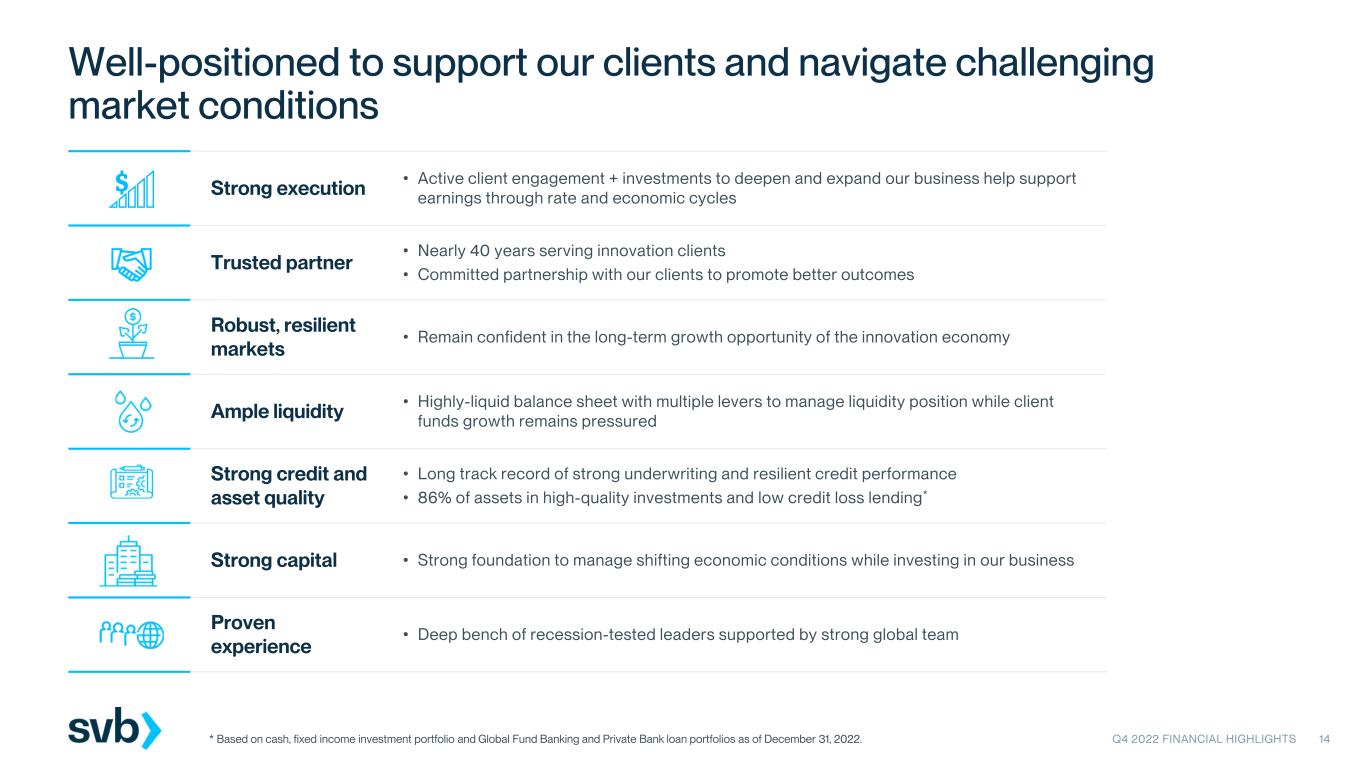
Well-positioned to support our clients and navigate challenging market conditions Strong execution • Active client engagement + investments to deepen and expand our business help support earnings through rate and economic cycles Trusted partner • Nearly 40 years serving innovation clients • Committed partnership with our clients to promote better outcomes Robust, resilient markets • Remain confident in the long-term growth opportunity of the innovation economy Ample liquidity • Highly-liquid balance sheet with multiple levers to manage liquidity position while client funds growth remains pressured Strong credit and asset quality • Long track record of strong underwriting and resilient credit performance • 86% of assets in high-quality investments and low credit loss lending* Strong capital • Strong foundation to manage shifting economic conditions while investing in our business Proven experience • Deep bench of recession-tested leaders supported by strong global team * Based on cash, fixed income investment portfolio and Global Fund Banking and Private Bank loan portfolios as of December 31, 2022. Q4 2022 FINANCIAL HIGHLIGHTS 14
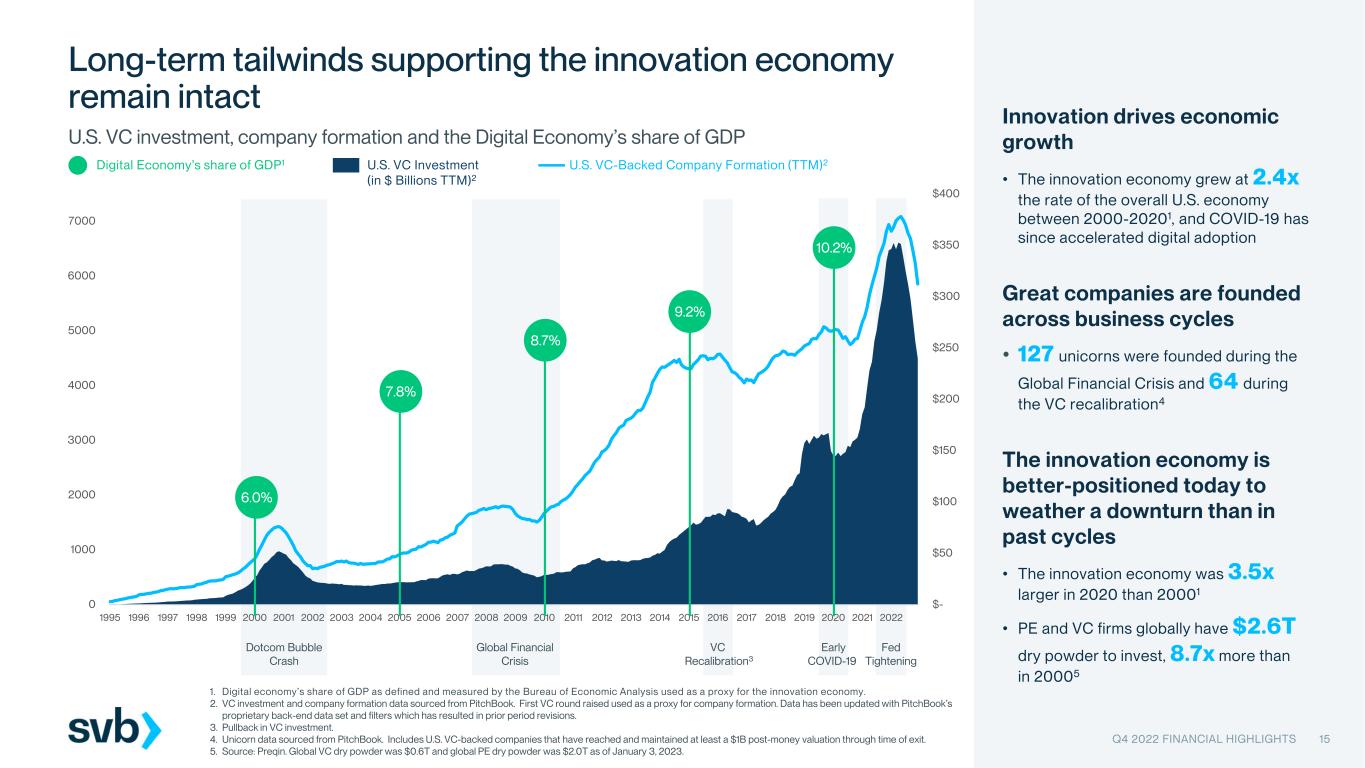
$- $50 $100 $150 $200 $250 $300 $350 $400 0 1000 2000 3000 4000 5000 6000 7000 1995 1996 1997 1998 1999 2000 2001 2002 2003 2004 2005 2006 2007 2008 2009 2010 2011 2012 2013 2014 2015 2016 2017 2018 2019 2020 2021 2022 6.0% 7.8% 8.7% 9.2% 10.2% Long-term tailwinds supporting the innovation economy remain intact 1. Digital economy’s share of GDP as defined and measured by the Bureau of Economic Analysis used as a proxy for the innovation economy. 2. VC investment and company formation data sourced from PitchBook. First VC round raised used as a proxy for company formation. Data has been updated with PitchBook’s proprietary back-end data set and filters which has resulted in prior period revisions. 3. Pullback in VC investment. 4. Unicorn data sourced from PitchBook. Includes U.S. VC-backed companies that have reached and maintained at least a $1B post-money valuation through time of exit. 5. Source: Preqin. Global VC dry powder was $0.6T and global PE dry powder was $2.0T as of January 3, 2023. Innovation drives economic growth • The innovation economy grew at 2.4x the rate of the overall U.S. economy between 2000-20201, and COVID-19 has since accelerated digital adoption Digital Economy’s share of GDP1 U.S. VC Investment (in $ Billions TTM)2 U.S. VC-Backed Company Formation (TTM)2 U.S. VC investment, company formation and the Digital Economy’s share of GDP Global Financial Crisis VC Recalibration3 Early COVID-19 Fed Tightening Dotcom Bubble Crash Great companies are founded across business cycles • 127 unicorns were founded during the Global Financial Crisis and 64 during the VC recalibration4 The innovation economy is better-positioned today to weather a downturn than in past cycles • The innovation economy was 3.5x larger in 2020 than 20001 • PE and VC firms globally have $2.6T dry powder to invest, 8.7x more than in 20005 Q4 2022 FINANCIAL HIGHLIGHTS 15

8 10 9 9 10 13 17 20 21 16 16 18 20 24 30 39 43 51 75 92 117 181 189 5 4 3 3 4 4 4 4 5 9 12 15 18 20 28 37 39 43 48 55 75 148 186 13 14 12 12 14 17 21 24 26 25 28 33 38 44 58 76 82 94 123 147 192 329 375 81% 6% -12% 2% 16% 22% 24% 15% 9% -4% 9% 20% 14% 15% 33% 29% 9% 15% 31% 19% 31% 71% 14% 120% -50% -22% -7% 16% 10% 25% 27% -3% -25% 16% 41% -8% 20% 47% 17% -3% 7% 62% 3% 14% 101% -31% -400% -300% -200% -100% 0% 100% 2000 2001 2002 2003 2004 2005 2006 2007 2008 2009 2010 2011 2012 2013 2014 2015 2016 2017 2018 2019 2020 2021 2022 Robust client funds growth over the long term Note: VC investment data sourced from PitchBook. Investment data has been updated with PitchBook’s proprietary back-end data set and filters which has resulted in prior period revisions. * Pullback in VC investment. - 10.0 20.0 30.0 40.0 50.0 Quarterly average TCF (positive growth, negative growth) Q4 2022 FINANCIAL HIGHLIGHTS 16 Global Financial Crisis VC Recalibration* Early COVID-19 Dotcom Bubble Crash Fed Tightening Average total client funds (“TCF”) $B Annual total client funds growth rate (positive, negative) On-balance sheet deposits Annual U.S. VC investment growth rate (positive, negative)Off-balance sheet client funds FY’22 vs. FY’21 YoY growth Average client funds +14% U.S. VC investment -31%

14% 1% 9% 55% 13% 7% 1% 7% 55% 35% 1%2% Other Fixed Income Securities Cash Non-marketable Securities Net Loans Ample liquidity + flexibility to manage liquidity position U.S. Treasury Securities Agency RMBS Agency CMBS AFS +HTM $117B Municipal Bonds Corporate Bonds 62% of assets in cash and fixed income securities 92% of fixed income portfolio in U.S. Treasuries and securities issued by government-sponsored enterprises Assets $212B Note: Figures as of December 31, 2022 unless otherwise noted. * Actual balances depend on timing of fund flows. ~ $2-3B estimated securities paydowns/quarter Securities cashflows $69B (FHLB, Repo, FRB and Fed Funds lines) Remaining borrowing capacity ~ 70% Modeled interest- bearing deposit beta Flexible on- vs. off-balance sheet liquidity solutions and deposit pricing strategies $79B Off-balance sheet sweep and repo client funds (OBS balances that can be shifted on-balance sheet to support deposits) Levers to support liquidity Targeting Fed cash at 4-6% of total deposits ($7-11B)* Agency CMOs – Fixed Rate High-quality, liquid balance sheet Q4 2022 FINANCIAL HIGHLIGHTS 17 Agency Debenture
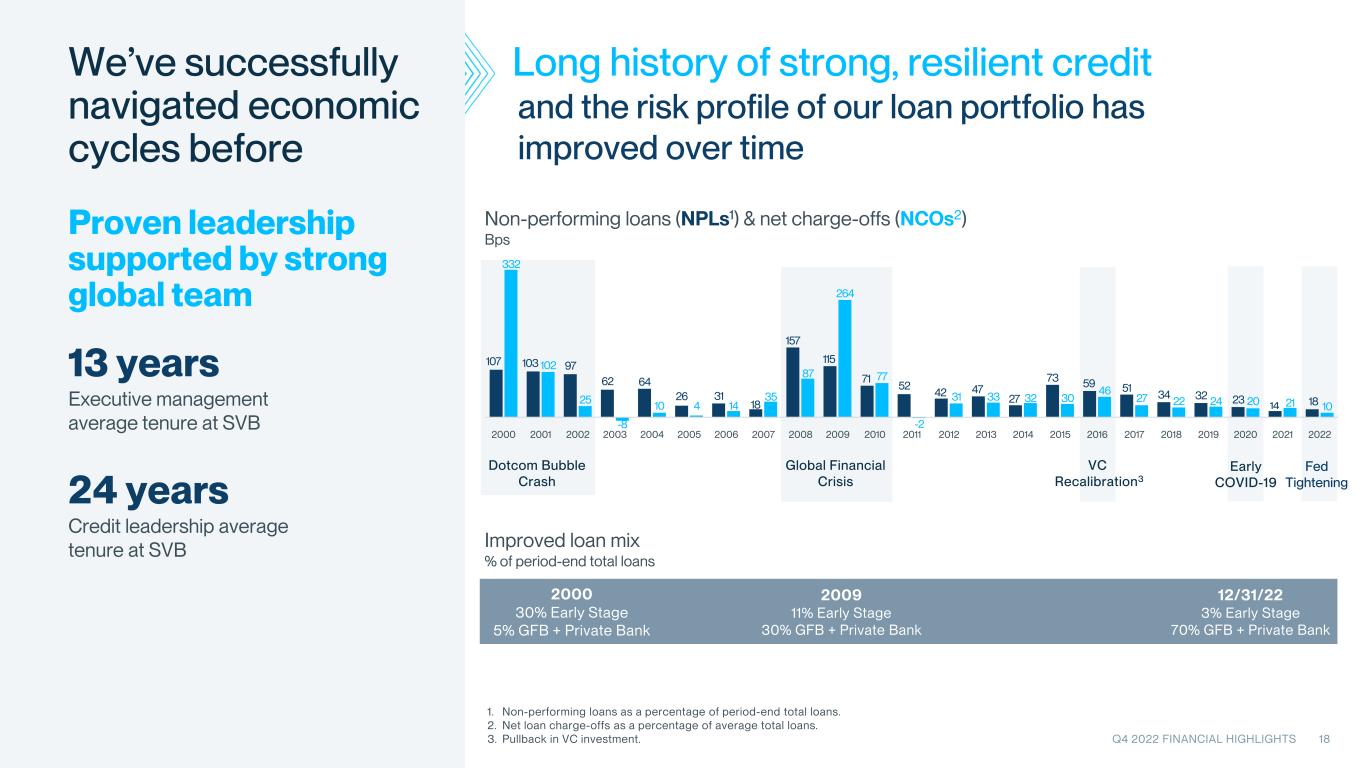
Non-performing loans (NPLs1) & net charge-offs (NCOs2) Bps Global Financial Crisis Dotcom Bubble Crash 2009 11% Early Stage 30% GFB + Private Bank 12/31/22 3% Early Stage 70% GFB + Private Bank 2000 30% Early Stage 5% GFB + Private Bank Early COVID-19 VC Recalibration3 and the risk profile of our loan portfolio has improved over time Long history of strong, resilient credit 1. Non-performing loans as a percentage of period-end total loans. 2. Net loan charge-offs as a percentage of average total loans. 3. Pullback in VC investment. Fed Tightening Improved loan mix % of period-end total loans 107 103 97 62 64 26 31 18 157 115 71 52 42 47 27 73 59 51 34 32 23 14 18 332 102 25 -8 10 4 14 35 87 264 77 -2 31 33 32 30 46 27 22 24 20 21 10 -10 40 90 140 190 240 290 340 2000 2001 2002 2003 2004 2005 2006 2007 2008 2009 2010 2011 2012 2013 2014 2015 2016 2017 2018 2019 2020 2021 2022 We’ve successfully navigated economic cycles before Proven leadership supported by strong global team 13 years Executive management average tenure at SVB 24 years Credit leadership average tenure at SVB Q4 2022 FINANCIAL HIGHLIGHTS 18
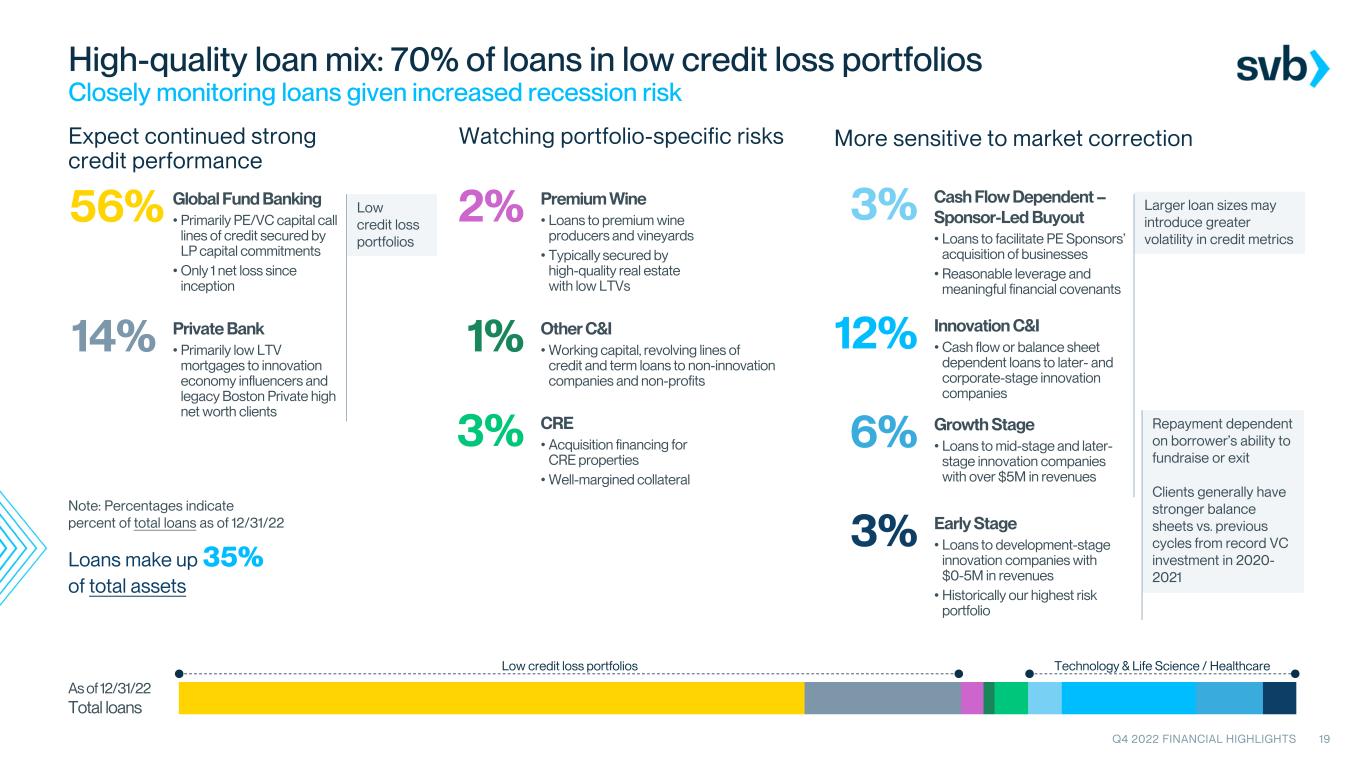
Technology & Life Science / HealthcareLow credit loss portfolios High-quality loan mix: 70% of loans in low credit loss portfolios Closely monitoring loans given increased recession risk Global Fund Banking • Primarily PE/VC capital call lines of credit secured by LP capital commitments •Only 1 net loss since inception 56% Expect continued strong credit performance Watching portfolio-specific risks More sensitive to market correction Private Bank • Primarily low LTV mortgages to innovation economy influencers and legacy Boston Private high net worth clients 14% Premium Wine • Loans to premium wine producers and vineyards • Typically secured by high-quality real estate with low LTVs 2% Other C&I •Working capital, revolving lines of credit and term loans to non-innovation companies and non-profits 1% CRE • Acquisition financing for CRE properties •Well-margined collateral 3% Innovation C&I • Cash flow or balance sheet dependent loans to later- and corporate-stage innovation companies 12% Cash Flow Dependent – Sponsor-Led Buyout • Loans to facilitate PE Sponsors’ acquisition of businesses • Reasonable leverage and meaningful financial covenants 3% Growth Stage • Loans to mid-stage and later- stage innovation companies with over $5M in revenues 6% Early Stage • Loans to development-stage innovation companies with $0-5M in revenues •Historically our highest risk portfolio 3% Larger loan sizes may introduce greater volatility in credit metrics Repayment dependent on borrower’s ability to fundraise or exit Clients generally have stronger balance sheets vs. previous cycles from record VC investment in 2020- 2021 Low credit loss portfolios As of 12/31/22 Total loans Note: Percentages indicate percent of total loans as of 12/31/22 Loans make up 35% of total assets Q4 2022 FINANCIAL HIGHLIGHTS 19
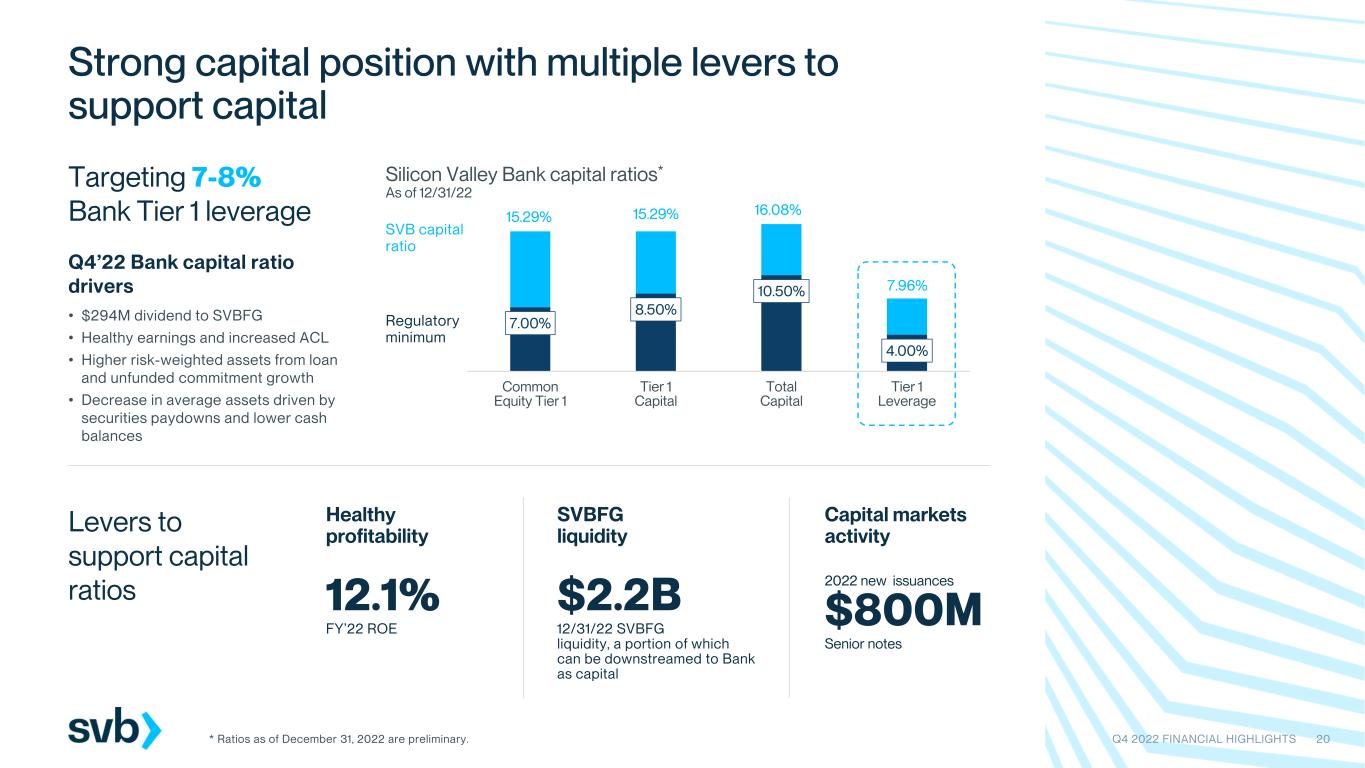
7.00% 8.50% 10.50% 4.00% 15.29% 15.29% 16.08% 7.96% Common Equity Tier 1 Tier 1 Capital Total Capital Tier 1 Leverage Silicon Valley Bank capital ratios* As of 12/31/22 Strong capital position with multiple levers to support capital SVB capital ratio Regulatory minimum Levers to support capital ratios Targeting 7-8% Bank Tier 1 leverage Q4’22 Bank capital ratio drivers • $294M dividend to SVBFG • Healthy earnings and increased ACL • Higher risk-weighted assets from loan and unfunded commitment growth • Decrease in average assets driven by securities paydowns and lower cash balances * Ratios as of December 31, 2022 are preliminary. 12.1% FY’22 ROE Healthy profitability $2.2B 12/31/22 SVBFG liquidity, a portion of which can be downstreamed to Bank as capital SVBFG liquidity Capital markets activity 2022 new issuances $800M Senior notes Q4 2022 FINANCIAL HIGHLIGHTS 20
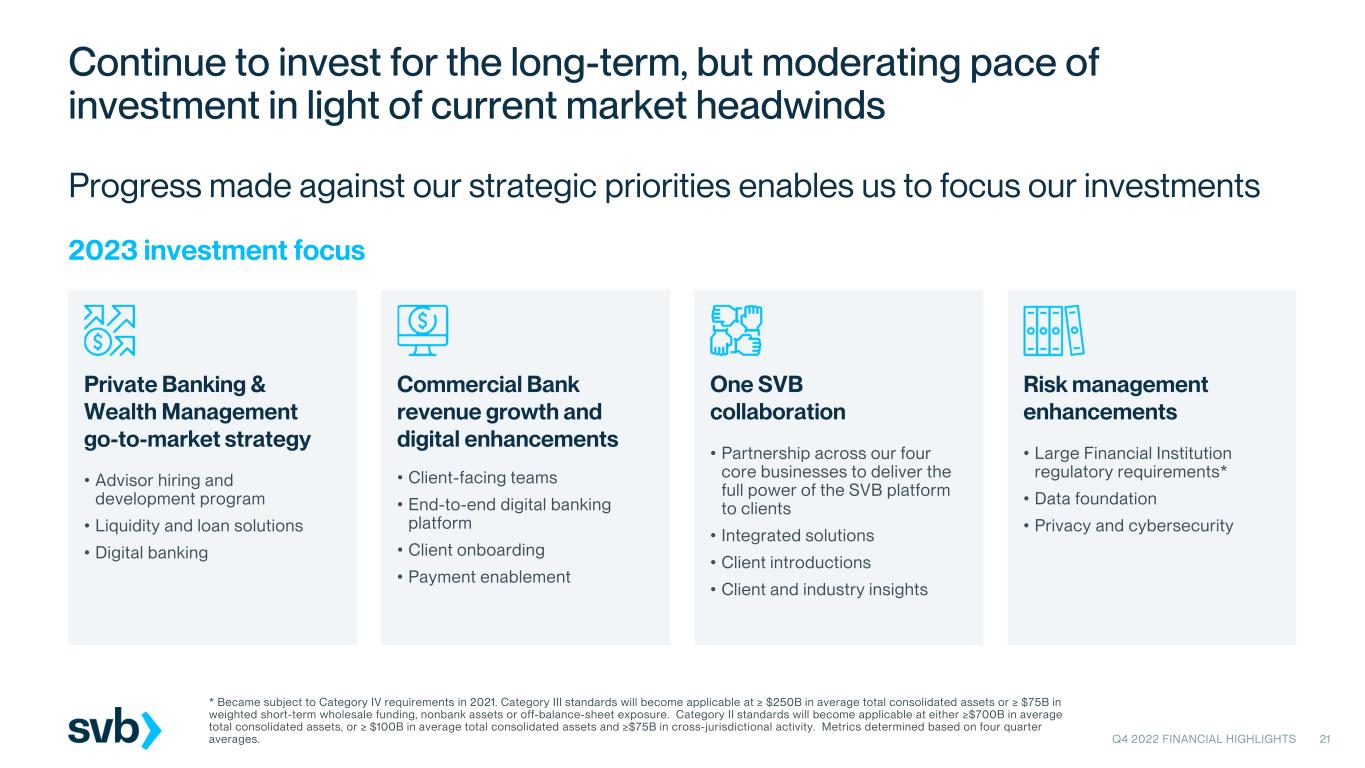
Q4 2022 FINANCIAL HIGHLIGHTS 21 Continue to invest for the long-term, but moderating pace of investment in light of current market headwinds * Became subject to Category IV requirements in 2021. Category III standards will become applicable at ≥ $250B in average total consolidated assets or ≥ $75B in weighted short-term wholesale funding, nonbank assets or off-balance-sheet exposure. Category II standards will become applicable at either ≥$700B in average total consolidated assets, or ≥ $100B in average total consolidated assets and ≥$75B in cross-jurisdictional activity. Metrics determined based on four quarter averages. Progress made against our strategic priorities enables us to focus our investments 2023 investment focus • Partnership across our four core businesses to deliver the full power of the SVB platform to clients • Integrated solutions • Client introductions • Client and industry insights • Large Financial Institution regulatory requirements* • Data foundation • Privacy and cybersecurity • Client-facing teams • End-to-end digital banking platform • Client onboarding • Payment enablement Private Banking & Wealth Management go-to-market strategy Commercial Bank revenue growth and digital enhancements One SVB collaboration Risk management enhancements • Advisor hiring and development program • Liquidity and loan solutions • Digital banking

Key takeaways Moderation in both client cash burn and pace of VC investment decline Strong and well- positioned Continued strength and momentum in underlying business Continued confidence in our strategy • Innovation propels global economic growth – we continue to believe the growth trajectory of the innovation economy will outpace other industries over the long term • Client engagement is very high as companies seek our advice as a trusted partner of the innovation economy • Strong Tech borrowing activity, client acquisition, GFB loan term sheets and PE/VC dry powder – all positive indicators of future business growth • Improving balance between inflows from private fundraising activity and outflows from client cash burn • Expect market and deposit mix + pricing pressures to persist near-term, but moderate, with NII and NIM improving by Q4’23 • We have a high-quality, liquid balance sheet; strong capital ratios; and multiple levers to manage liquidity • Our investments in our four core businesses have expanded our capabilities and diversified our revenues – enhancing our ability to serve our clients • While prolonged market volatility will likely increase NPLs and NCOs from historic lows, we still expect overall healthy credit performance, with losses concentrated in Early Stage (only 3% of loans) Q4 2022 FINANCIAL HIGHLIGHTS 22

Performance detail and outlook drivers Q4 2022 FINANCIAL HIGHLIGHTS 23
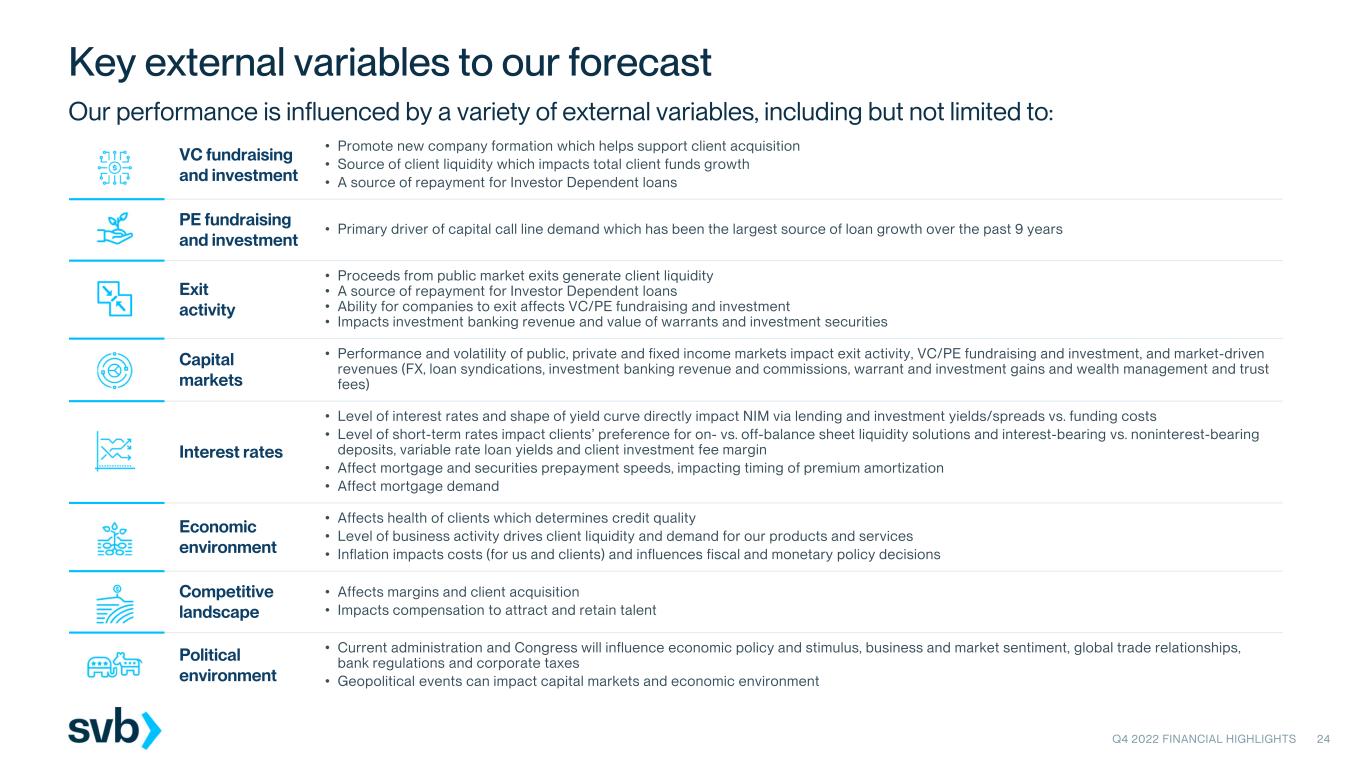
VC fundraising and investment • Promote new company formation which helps support client acquisition • Source of client liquidity which impacts total client funds growth • A source of repayment for Investor Dependent loans PE fundraising and investment • Primary driver of capital call line demand which has been the largest source of loan growth over the past 9 years Exit activity • Proceeds from public market exits generate client liquidity • A source of repayment for Investor Dependent loans • Ability for companies to exit affects VC/PE fundraising and investment • Impacts investment banking revenue and value of warrants and investment securities Capital markets • Performance and volatility of public, private and fixed income markets impact exit activity, VC/PE fundraising and investment, and market-driven revenues (FX, loan syndications, investment banking revenue and commissions, warrant and investment gains and wealth management and trust fees) Interest rates • Level of interest rates and shape of yield curve directly impact NIM via lending and investment yields/spreads vs. funding costs • Level of short-term rates impact clients’ preference for on- vs. off-balance sheet liquidity solutions and interest-bearing vs. noninterest-bearing deposits, variable rate loan yields and client investment fee margin • Affect mortgage and securities prepayment speeds, impacting timing of premium amortization • Affect mortgage demand Economic environment • Affects health of clients which determines credit quality • Level of business activity drives client liquidity and demand for our products and services • Inflation impacts costs (for us and clients) and influences fiscal and monetary policy decisions Competitive landscape • Affects margins and client acquisition • Impacts compensation to attract and retain talent Political environment • Current administration and Congress will influence economic policy and stimulus, business and market sentiment, global trade relationships, bank regulations and corporate taxes • Geopolitical events can impact capital markets and economic environment Key external variables to our forecast Our performance is influenced by a variety of external variables, including but not limited to: Q4 2022 FINANCIAL HIGHLIGHTS 24
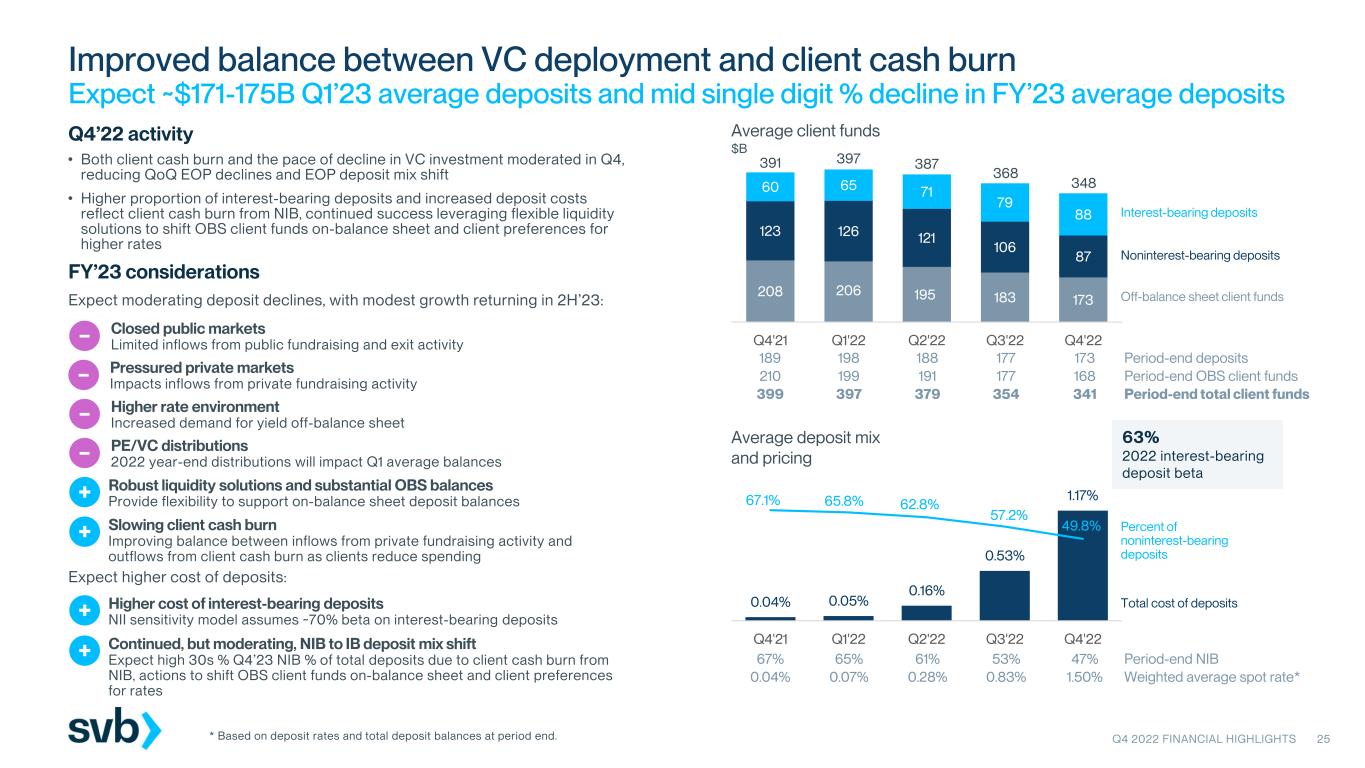
Improved balance between VC deployment and client cash burn Expect ~$171-175B Q1’23 average deposits and mid single digit % decline in FY’23 average deposits Average client funds $B PE/VC distributions 2022 year-end distributions will impact Q1 average balances – Expect moderating deposit declines, with modest growth returning in 2H’23: FY’23 considerations Average deposit mix and pricing 208 206 195 183 173 123 126 121 106 87 60 65 71 79 88 391 397 387 368 348 Q4'21 Q1'22 Q2'22 Q3'22 Q4'22 0.04% 0.05% 0.16% 0.53% 1.17%67.1% 65.8% 62.8% 57.2% 49.8% 0% 10% 20% 30% 40% 50% 60% 70% 80% 0.00% 0.20% 0.40% 0.60% 0.80% 1.00% 1.20% 1.40% Q4'21 Q1'22 Q2'22 Q3'22 Q4'22 Off-balance sheet client funds Noninterest-bearing deposits Interest-bearing deposits Percent of noninterest-bearing deposits Total cost of deposits Robust liquidity solutions and substantial OBS balances Provide flexibility to support on-balance sheet deposit balances+ 63% 2022 interest-bearing deposit beta Expect higher cost of deposits: Continued, but moderating, NIB to IB deposit mix shift Expect high 30s % Q4’23 NIB % of total deposits due to client cash burn from NIB, actions to shift OBS client funds on-balance sheet and client preferences for rates + Higher cost of interest-bearing deposits NII sensitivity model assumes ~70% beta on interest-bearing deposits+ Higher rate environment Increased demand for yield off-balance sheet – Closed public markets Limited inflows from public fundraising and exit activity – Slowing client cash burn Improving balance between inflows from private fundraising activity and outflows from client cash burn as clients reduce spending + • Both client cash burn and the pace of decline in VC investment moderated in Q4, reducing QoQ EOP declines and EOP deposit mix shift • Higher proportion of interest-bearing deposits and increased deposit costs reflect client cash burn from NIB, continued success leveraging flexible liquidity solutions to shift OBS client funds on-balance sheet and client preferences for higher rates Q4’22 activity * Based on deposit rates and total deposit balances at period end. Q4 2022 FINANCIAL HIGHLIGHTS 25 189 198 188 177 173 Period-end deposits 210 199 191 177 168 Period-end OBS client funds 399 397 379 354 341 Period-end total client funds Pressured private markets Impacts inflows from private fundraising activity – 67% 65% 61% 53% 47% Period-end NIB 0.04% 0.07% 0.28% 0.83% 1.50% Weighted average spot rate*
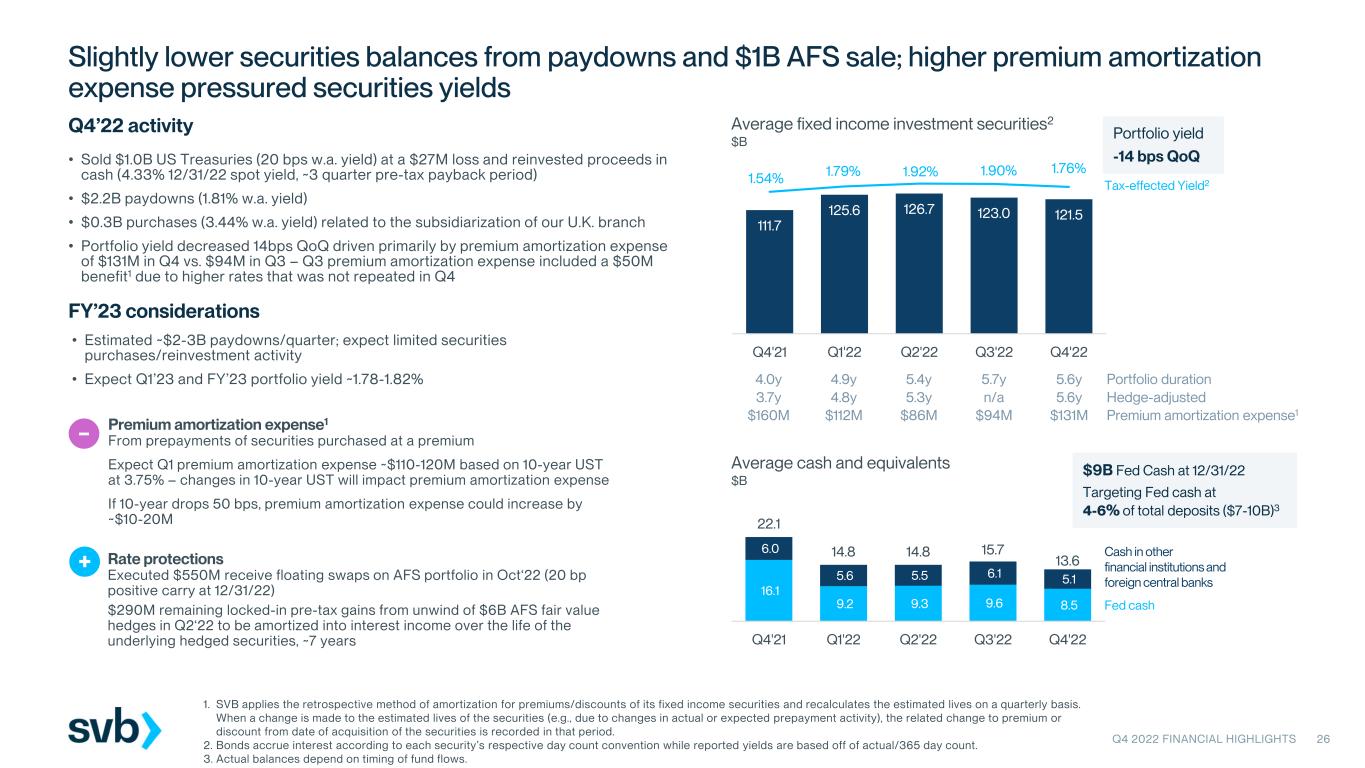
111.7 125.6 126.7 123.0 121.5 1.54% 1.79% 1.92% 1.90% 1.76% 0.0 20.0 40.0 60.0 80.0 100.0 120.0 140.0 Q4'21 Q1'22 Q2'22 Q3'22 Q4'22 16.1 9.2 9.3 9.6 8.5 6.0 5.6 5.5 6.1 5.1 22.1 14.8 14.8 15.7 13.6 Q4'21 Q1'22 Q2'22 Q3'22 Q4'22 Slightly lower securities balances from paydowns and $1B AFS sale; higher premium amortization expense pressured securities yields 1. SVB applies the retrospective method of amortization for premiums/discounts of its fixed income securities and recalculates the estimated lives on a quarterly basis. When a change is made to the estimated lives of the securities (e.g., due to changes in actual or expected prepayment activity), the related change to premium or discount from date of acquisition of the securities is recorded in that period. 2. Bonds accrue interest according to each security’s respective day count convention while reported yields are based off of actual/365 day count. 3. Actual balances depend on timing of fund flows. Average fixed income investment securities2 $B Average cash and equivalents $B Tax-effected Yield2 • Estimated ~$2-3B paydowns/quarter; expect limited securities purchases/reinvestment activity • Expect Q1’23 and FY’23 portfolio yield ~1.78-1.82% FY’23 considerations 4.0y 4.9y 5.4y 5.7y 5.6y Portfolio duration 3.7y 4.8y 5.3y n/a 5.6y Hedge-adjusted $160M $112M $86M $94M $131M Premium amortization expense1 Fed cash Cash in other financial institutions and foreign central banks $9B Fed Cash at 12/31/22 Targeting Fed cash at 4-6% of total deposits ($7-10B)3 Premium amortization expense1 From prepayments of securities purchased at a premium Expect Q1 premium amortization expense ~$110-120M based on 10-year UST at 3.75% – changes in 10-year UST will impact premium amortization expense If 10-year drops 50 bps, premium amortization expense could increase by ~$10-20M – • Sold $1.0B US Treasuries (20 bps w.a. yield) at a $27M loss and reinvested proceeds in cash (4.33% 12/31/22 spot yield, ~3 quarter pre-tax payback period) • $2.2B paydowns (1.81% w.a. yield) • $0.3B purchases (3.44% w.a. yield) related to the subsidiarization of our U.K. branch • Portfolio yield decreased 14bps QoQ driven primarily by premium amortization expense of $131M in Q4 vs. $94M in Q3 – Q3 premium amortization expense included a $50M benefit1 due to higher rates that was not repeated in Q4 Q4’22 activity Rate protections Executed $550M receive floating swaps on AFS portfolio in Oct‘22 (20 bp positive carry at 12/31/22) $290M remaining locked-in pre-tax gains from unwind of $6B AFS fair value hedges in Q2‘22 to be amortized into interest income over the life of the underlying hedged securities, ~7 years Q4 2022 FINANCIAL HIGHLIGHTS 26 Portfolio yield -14 bps QoQ +

Continued healthy loan growth driven by GFB capital call, Tech and Private Bank mortgage borrowing Expect ~$74-76B Q1’23 average loans and low double digit % growth in FY’23 average loans Average Loans $B Expect moderate loan growth: Boston Private purchase accounting Amortization of fair value mark ups on loans ($24M remaining at 12/31/22, vast majority to be amortized by end of 2023) – Consistent SVB Private mortgage origination Referrals from commercial clients offset reduced demand from higher rates and economic uncertainty + Healthy Tech and Life Science/Healthcare borrowing Market volatility fueling demand+ FY’23 considerations 4.83% 6.03% 1.14% 0.01% 0.05% Q3'22 loan yield Rate hikes Loan mix Loan fees Q4'22 loan yield Global Fund Banking Private Bank PPP Premium Wine and Other Tech and Life Science/HC Average Loan Yield CRE Other C&I Expect higher loan yields: Rate protections $60M remaining locked-in pre-tax swap gains from unwind of loan cash flow hedges as of 12/31/22 (vast majority to be amortized by end of 2023) + 60.3% 60.6% 58.4% 56.4% 54.3% Portfolio utilization Current strong GFB pipeline New originations to offset pressured utilization from slowdown in PE/VC investment activity + 34.4 38.1 39.2 39.5 40.5 13.2 14.0 14.8 15.5 16.3 8.6 9.0 9.5 9.9 10.3 2.0 1.8 2.0 2.5 2.9 1.4 1.3 1.1 1.1 1.0 2.7 2.7 2.6 2.6 2.6 0.3 0.2 0.1 0.0 0.0 62.6 67.1 69.3 71.1 73.6 Q4'21 Q1'22 Q2'22 Q3'22 Q4'22 • GFB capital call growth driven by new originations, offsetting lower utilization rates as PE/VC investment slowed – GFB term sheets continue to be at near record highs • Persistent market volatility continued to fuel strong Tech growth as clients turned to debt as an alternative to raising equity at pressured valuations • Continued Private Bank mortgage momentum driven by new purchase activity; refi demand remained pressured by rate environment Q4’22 activity Q4 2022 FINANCIAL HIGHLIGHTS 27 Higher yields with future rate hikes 92% of Q4’22 average loans were variable rate+

2.28% 2.00% (0.50%) (0.25%) 0.43% 0.04% Q3'22 NIM Higher interest earning yields Balance sheet mix Higher deposit costs Higher borrowing costs Q4'22 NIM 1,207 1,047 (17) (37) (13) (265) (130) 208 11 35 48 Q3'22 NII Higher loan yields Higher loan fees Loan growth Higher cash yields Lower cash balance Fixed income premium amortization Fixed income paydowns Higher deposit costs Higher borrowing costs Q4'22 NII Lower NII and NIM despite higher loan yields as liability mix shift pressured interest expense and premium amortization expense increased; expect near-term NII and NIM pressure, with improvement by Q4’23 NII: Expect ~$925-955M in Q1’23 and high teens % decline in FY’23 NIM: Expect ~1.85-1.95% in Q1’23 and 1.75-1.85% in FY’23 FY’23 considerationsNet Interest Income1 $M NII -13% QoQ Net Interest Margin 1. NII is presented on a fully taxable equivalent basis, while NII guidance excludes fully taxable equivalent adjustments. 2. SVB applies the retrospective method of amortization for premiums/discounts of its fixed income securities and recalculates the estimated lives on a quarterly basis. When a change is made to the estimated lives of the securities (e.g., due to changes in actual or expected prepayment activity), the related change to premium or discount from date of acquisition of the securities is recorded in that period. Higher loan yields From future Fed rate hikes (see page 27) + Boston Private purchase accounting Amortization of fair value mark ups on loans ($24M remaining at 12/31/22, vast majority to be amortized by end of 2023) – Higher deposit costs Given rising rate environment and continued, but moderating, NIB to IB deposit mix shift (see page 25) – NIM -28 bps QoQ Premium amortization expense From prepayments of securities purchased at a premium (see page 26) – Expect near-term NII and NIM pressure, with improvement by Q4’23: Q4 2022 FINANCIAL HIGHLIGHTS 28 Includes $130M of higher deposit costs from shifting OBS client funds to on- balance sheet deposits Rate protections Executed $550M receive floating swaps on AFS portfolio in Oct ‘22 (20 bp positive carry at 12/31/22) $290M remaining locked-in pre-tax gains from unwind of $6B AFS fair value hedges in Q3’22 to be amortized into interest income over the life of the underlying hedged securities, ~7 years $60M remaining locked-in pre-tax swap gains from unwind of loan cash flow hedges as of 12/31/22 (vast majority to be amortized by end of 2023) + Q3 premium amortization expense included a $50M benefit due to higher rates that was not repeated in Q42 Improving balance between VC investment and client cash burn Supports modest deposit growth in 2H’23 +

20 15 18 18 22 2 (13) 16 (11) 26 3 4 (2) 6 20 10 27 22 4 50 42 37 1 (1) 0 3 89 9 31 Q4'21 Q1'22 Q2'22 Q3'22 Q4'22 Provision driven by increased NCOs and NPLs, strong growth and model assumptions While prolonged market volatility likely increases credit losses and NPLs from historic lows, still expect overall healthy credit performance (expect 15-35 bps Q1’23 and FY’23 NCOs) Credit quality metrics Provision for credit losses $M Q4’21 Q1’22 Q2’22 Q3’22 Q4’22 0.01% 0.05% 0.12% 0.08% 0.15% 0.14% 0.10% 0.13% 0.11% 0.18% Non-performing loans2 Net charge-offs1 Non-performing loans Loan growth Model assumptions Unfunded Net credit losses HTM securities $48 $11 $196 $72 $141 1 While prolonged market volatility likely increases credit losses and NPLs from historic lows, still expect overall healthy credit performance, with losses concentrated in Early Stage: 30% downside 40% baseline 30% upside Weightings applied to Moody’s December economic scenarios FY’23 considerationsQ4’22 activity Other • Increase in QoQ NCOs (+$13M), NPLs (+$55M) and Criticized (+$230M) reflect current market challenges • Provision driven primarily by: – $36M gross charge-offs not previously specifically reserved for, driven primarily by Early Stage and Growth Stage portfolios, partially offset by $9M recoveries – $26M from higher NPLs, driven primarily by Investor Dependent and Innovation C&I portfolios – $46M from robust loan and unfunded commitment growth – $44M from model assumptions (deterioration in projected economic conditions and increased weighted average life of loan portfolio) Stronger client balance sheets vs. previous cycles Record VC investment in 2020-2021 has generally extended client runway and clients are taking steps to reduce burn + Larger Growth Stage, Innovation C&I and Cash Flow Dependent – Sponsor-Led Buyout loan sizes Growth of our balance sheet and our clients has increased the number of large loans, which may introduce greater volatility in credit metrics, but expect more limited migration from NPLs to NCOs – High-quality loan mix 70% of loans in low credit loss GFB and Private Bank portfolios Early Stage – historically our highest risk portfolio – only 3% of loans + CRE loans acquired from Boston Private Limited overall exposure (only 3% of total loans) and well-margined collateral – Pressured public and private markets Likely impacts performance of Tech and Life Science/Healthcare portfolio, particularly Investor Dependent loans where repayment is dependent on borrower’s ability to fundraise or exit – Q4 2022 FINANCIAL HIGHLIGHTS 29 1. Net loan charge-offs as a percentage of average total loans (annualized). 2. Non-performing loans as a percentage of period-end total loans.
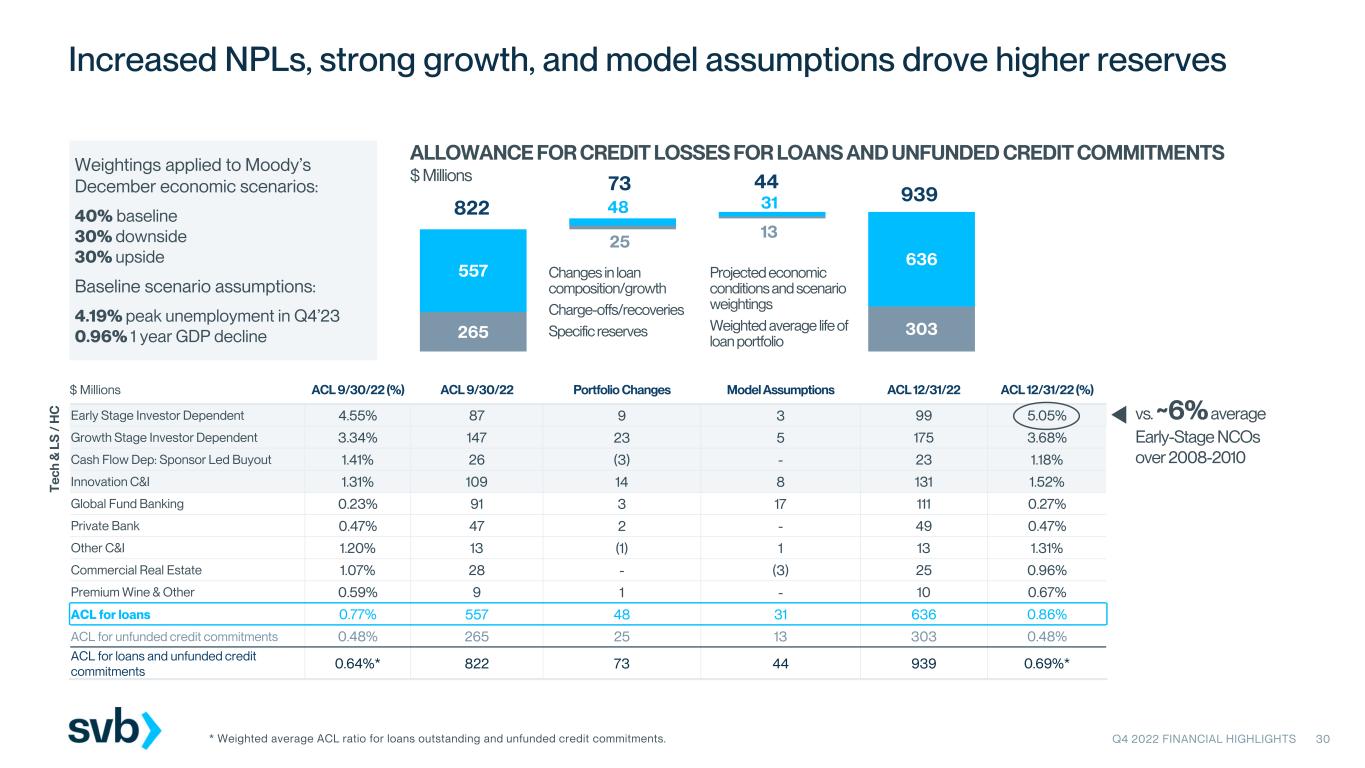
$ Millions ACL 9/30/22 (%) ACL 9/30/22 Portfolio Changes Model Assumptions ACL 12/31/22 ACL 12/31/22 (%) Early Stage Investor Dependent 4.55% 87 9 3 99 5.05% Growth Stage Investor Dependent 3.34% 147 23 5 175 3.68% Cash Flow Dep: Sponsor Led Buyout 1.41% 26 (3) - 23 1.18% Innovation C&I 1.31% 109 14 8 131 1.52% Global Fund Banking 0.23% 91 3 17 111 0.27% Private Bank 0.47% 47 2 - 49 0.47% Other C&I 1.20% 13 (1) 1 13 1.31% Commercial Real Estate 1.07% 28 - (3) 25 0.96% Premium Wine & Other 0.59% 9 1 - 10 0.67% ACL for loans 0.77% 557 48 31 636 0.86% ACL for unfunded credit commitments 0.48% 265 25 13 303 0.48% ACL for loans and unfunded credit commitments 0.64%* 822 73 44 939 0.69%* ALLOWANCE FOR CREDIT LOSSES FOR LOANS AND UNFUNDED CREDIT COMMITMENTS $ Millions 265 303 557 636 25 13 822 48 31 939 Changes in loan composition/growth Charge-offs/recoveries Specific reserves Projected economic conditions and scenario weightings Weighted average life of loan portfolio 4473 Increased NPLs, strong growth, and model assumptions drove higher reserves T e c h & L S / H C vs. ~6%average Early-Stage NCOs over 2008-2010 * Weighted average ACL ratio for loans outstanding and unfunded credit commitments. Weightings applied to Moody’s December economic scenarios: 40% baseline 30% downside 30% upside Baseline scenario assumptions: 4.19% peak unemployment in Q4’23 0.96% 1 year GDP decline Q4 2022 FINANCIAL HIGHLIGHTS 30
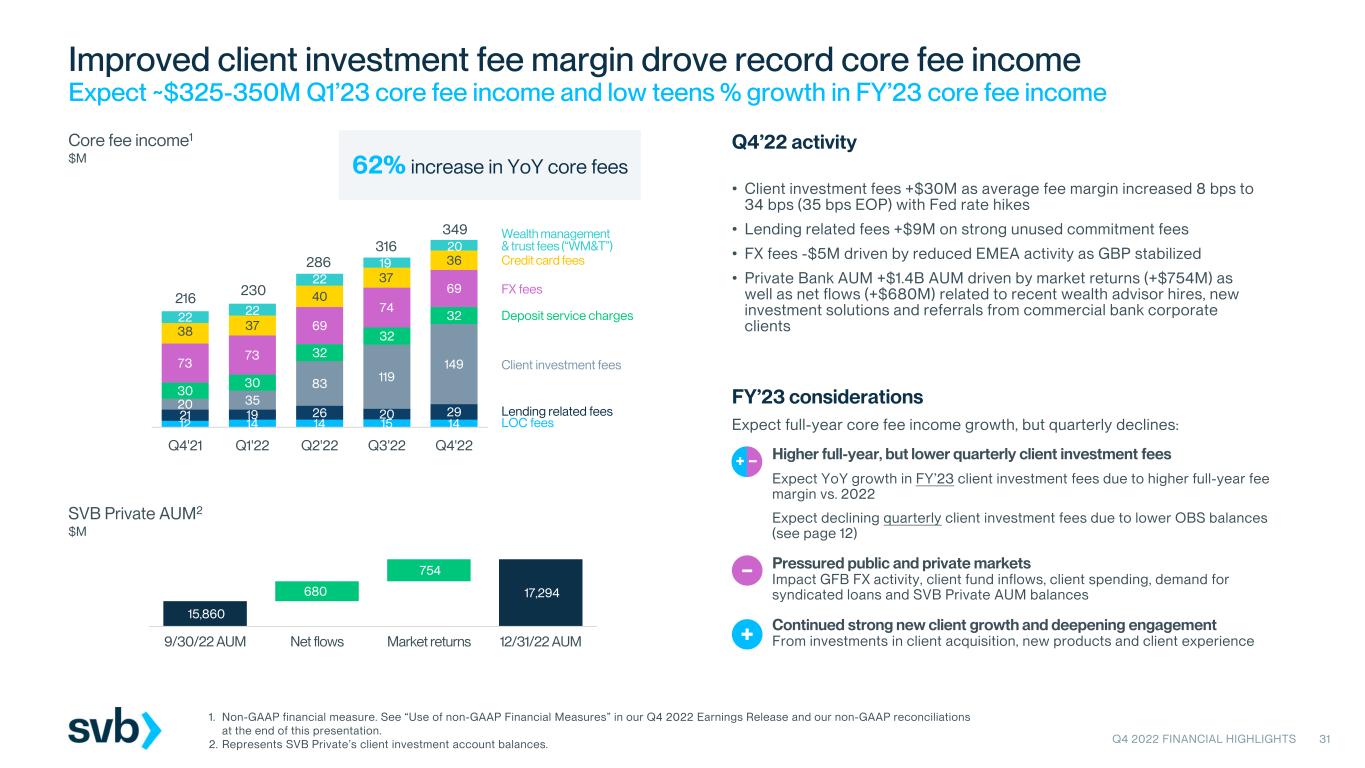
12 14 14 15 14 21 19 26 20 29 20 35 83 119 149 30 30 32 32 32 73 73 69 74 69 38 37 40 37 36 22 22 22 19 20 0 0 0 0 0 0 Q4'21 Q1'22 Q2'22 Q3'22 Q4'22 Improved client investment fee margin drove record core fee income Expect ~$325-350M Q1’23 core fee income and low teens % growth in FY’23 core fee income Core fee income1 $M • Client investment fees +$30M as average fee margin increased 8 bps to 34 bps (35 bps EOP) with Fed rate hikes • Lending related fees +$9M on strong unused commitment fees • FX fees -$5M driven by reduced EMEA activity as GBP stabilized • Private Bank AUM +$1.4B AUM driven by market returns (+$754M) as well as net flows (+$680M) related to recent wealth advisor hires, new investment solutions and referrals from commercial bank corporate clients Continued strong new client growth and deepening engagement From investments in client acquisition, new products and client experience+ Lending related fees Deposit service charges Credit card fees LOC fees FX fees Wealth management & trust fees (“WM&T”) FY’23 considerations 1. Non-GAAP financial measure. See “Use of non-GAAP Financial Measures” in our Q4 2022 Earnings Release and our non-GAAP reconciliations at the end of this presentation. 2. Represents SVB Private’s client investment account balances. Client investment fees SVB Private AUM2 $M 15,860 17,294 680 754 9/30/22 AUM Net flows Market returns 12/31/22 AUM Pressured public and private markets Impact GFB FX activity, client fund inflows, client spending, demand for syndicated loans and SVB Private AUM balances – 216 230 286 316 349 Expect full-year core fee income growth, but quarterly declines: Q4’22 activity 62% increase in YoY core fees Q4 2022 FINANCIAL HIGHLIGHTS 31 Higher full-year, but lower quarterly client investment fees Expect YoY growth in FY’23 client investment fees due to higher full-year fee margin vs. 2022 Expect declining quarterly client investment fees due to lower OBS balances (see page 12) + –
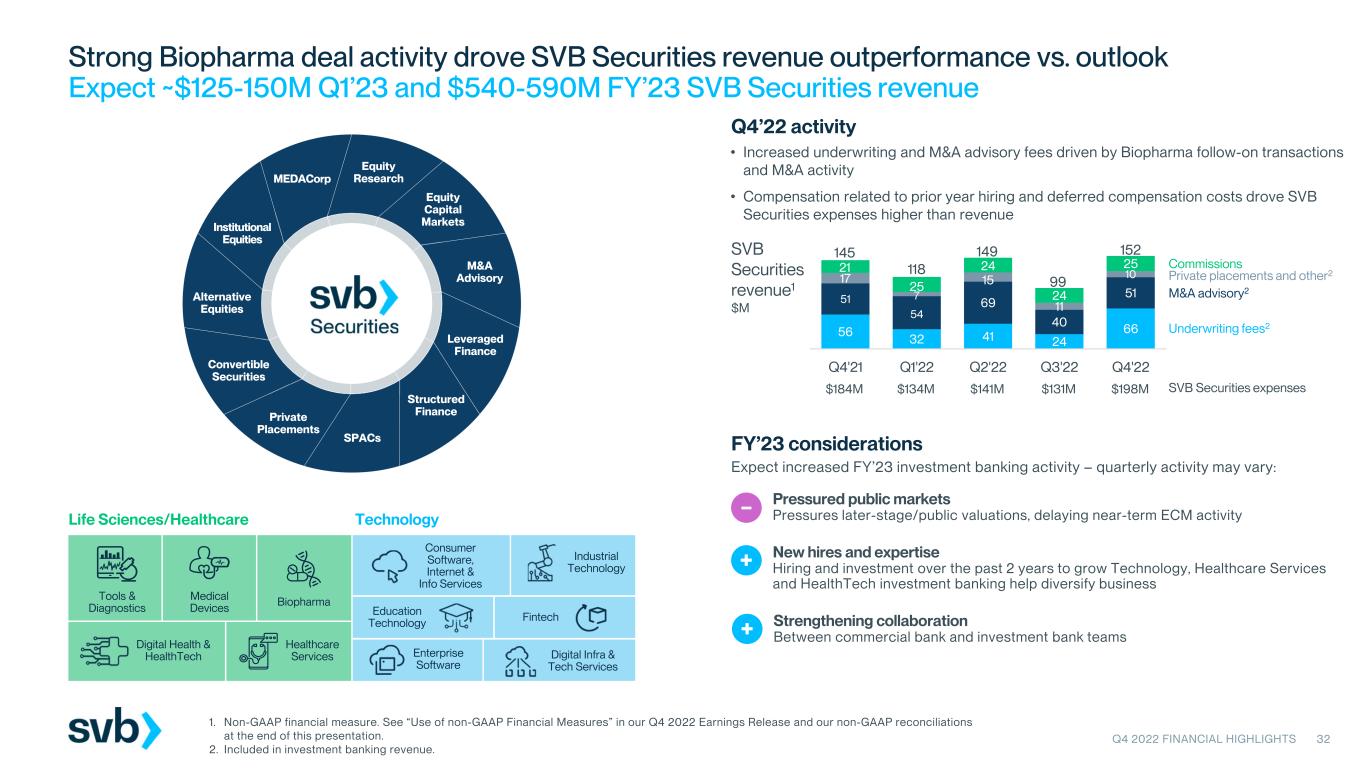
SVB Securities expenses • Increased underwriting and M&A advisory fees driven by Biopharma follow-on transactions and M&A activity • Compensation related to prior year hiring and deferred compensation costs drove SVB Securities expenses higher than revenue Strong Biopharma deal activity drove SVB Securities revenue outperformance vs. outlook Expect ~$125-150M Q1’23 and $540-590M FY’23 SVB Securities revenue 1. Non-GAAP financial measure. See “Use of non-GAAP Financial Measures” in our Q4 2022 Earnings Release and our non-GAAP reconciliations at the end of this presentation. 2. Included in investment banking revenue. New hires and expertise Hiring and investment over the past 2 years to grow Technology, Healthcare Services and HealthTech investment banking help diversify business + FY’23 considerations Q4’22 activity SVB Securities revenue1 $M Equity Capital Markets Convertible Securities Alternative Equities Institutional Equities MEDACorp M&A Advisory Equity Research Leveraged Finance Structured Finance SPACs Private Placements TechnologyLife Sciences/Healthcare Tools & Diagnostics Medical Devices Biopharma Healthcare Services Digital Health & HealthTech Pressured public markets Pressures later-stage/public valuations, delaying near-term ECM activity – Strengthening collaboration Between commercial bank and investment bank teams+ Underwriting fees2 M&A advisory2 Commissions Private placements and other2 Education Technology Industrial Technology Enterprise Software Digital Infra & Tech Services Fintech Consumer Software, Internet & Info Services Expect increased FY’23 investment banking activity – quarterly activity may vary: 56 32 41 24 66 51 54 69 40 51 17 7 15 11 10 21 25 24 24 25 145 118 149 99 152 Q4'21 Q1'22 Q2'22 Q3'22 Q4'22 $184M $134M $141M $131M $198M Q4 2022 FINANCIAL HIGHLIGHTS 32

32 49 54 18 -136 -76 -50 69 63 17 40 28 -1 -27 155 130 -120 -36 -49 Q4'21 Q1'22 Q2'22 Q3'22 Q4'22 Note: The extent to which unrealized gains (or losses) from investment securities from our non-marketable and other equity securities portfolio as well as our equity warrant assets will become realized is subject to a variety of factors, including, among other things, performance of the underlying portfolio companies, investor demand for IPOs and SPACs, fluctuations in the underlying valuation of these companies, levels of M&A activity and legal and contractual restrictions on our ability to sell the underlying securities. 1. Non-GAAP financial measure. See “Use of non-GAAP Financial Measures” in our Q4 2022 Earnings Release and our non-GAAP reconciliations at the end of this presentation. 2. Net of investments in qualified affordable housing projects and noncontrolling interests. Warrant and investment gains (losses) Net of NCI1 $M Outlook considerations Warrants & non-marketable and other equity securities1, 2 $M Warrant gains Investment gains (losses) less AFS sales Warrants Non-marketable and other equity securities1, 2 Pressured public and private markets Slows PE/VC investment Fewer exits reduce opportunities to realize gains – Granular, diversified positions Warrants: Only 65 warrants out of 3,234 positions with a fair value >$1M, collectively representing $199M in fair value Private fund investments: Exposure to over 500 funds with nearly 25,000 investments in ~10,000 companies across various industries and stages of development + Gains (losses) from AFS sales 1,222 1,259 1,153 1,083 1,066 277 323 322 351 383 12/31/21 3/31/22 6/30/22 9/30/22 12/31/22 Q4’22 activity Expect muted warrant gains and additional private fund investment losses given prolonged market volatility: Private funds’ 2022 year-end audit and valuation cycle Funds’ annual audit and valuation process may result in valuation declines that drive additional private fund investment losses (estimated ~$50-60M) through 1H’23 – Increased potential for down rounds Clients generally have extended runway, but eventually will need to raise funds – Q4 2022 FINANCIAL HIGHLIGHTS 33 Continued market volatility and $1B sale of AFS securities drove investment losses Expect muted warrant gains and additional private fund investment losses given prolonged market volatility • Investment losses net of NCI included: – $50M investment losses driven primarily by further valuation declines in our managed funds and strategic investments reflective of continued adverse market conditions – $27M realized loss on the sale of $1B AFS U.S. Treasuries • $28M warrant gains driven primarily by valuation updates and M&A activity

-3 8 3 3 22 23 11 0 7 37 19 46 71 71 38 55 89 138 237 560 148 -13 -1 0 -2 -7 -10 -16 -58 -23 -1 -21 -26 -30 -12 -45 -35 -28 -23 -27 -28 -40 2002 2003 2004 2005 2006 2007 2008 2009 2010 2011 2012 2013 2014 2015 2016 2017 2018 2019 2020 2021 2022 Net warrant gains more than offset Early Stage charge-offs over time and offer meaningful long-term earnings support Net gains on equity warrant assets Cumulative net gains (2002-2022 warrant gains less Early Stage NCOs) Early Stage NCOs $1.1B Warrant gains net of Early Stage losses $M Q4 2022 FINANCIAL HIGHLIGHTS 34
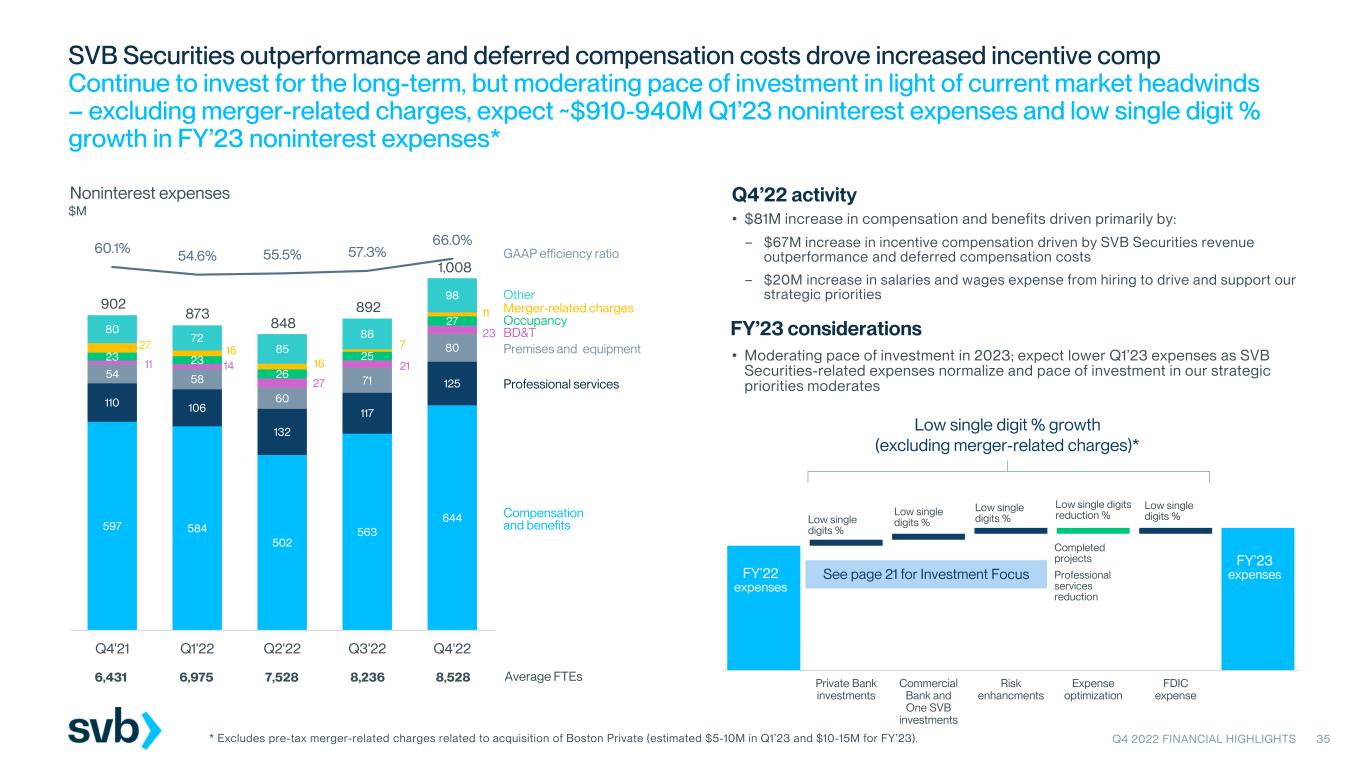
Private Bank investments Commercial Bank and One SVB investments Risk enhancments Expense optimization FDIC expense FY’23 expensesFY’22 expenses Low single digits % Completed projects Professional services reduction Low single digits % Low single digits % Low single digits % Low single digits reduction % See page 21 for Investment Focus 597 584 502 563 644 110 106 132 117 125 54 58 60 71 80 11 14 27 21 23 23 23 26 25 27 27 16 16 7 11 80 72 85 88 98 902 873 848 892 1,008 60.1% 54.6% 55.5% 57.3% 66.0% 0 200 400 600 800 1000 1200 Q4'21 Q1'22 Q2'22 Q3'22 Q4'22 SVB Securities outperformance and deferred compensation costs drove increased incentive comp Continue to invest for the long-term, but moderating pace of investment in light of current market headwinds – excluding merger-related charges, expect ~$910-940M Q1’23 noninterest expenses and low single digit % growth in FY’23 noninterest expenses* * Excludes pre-tax merger-related charges related to acquisition of Boston Private (estimated $5-10M in Q1’23 and $10-15M for FY’23). FY’23 considerations Noninterest expenses $M 6,431 6,975 7,528 8,236 8,528 Average FTEs GAAP efficiency ratio Other Occupancy BD&T Premises and equipment Professional services Compensation and benefits Merger-related charges • $81M increase in compensation and benefits driven primarily by: – $67M increase in incentive compensation driven by SVB Securities revenue outperformance and deferred compensation costs – $20M increase in salaries and wages expense from hiring to drive and support our strategic priorities Q4’22 activity Q4 2022 FINANCIAL HIGHLIGHTS 35 • Moderating pace of investment in 2023; expect lower Q1’23 expenses as SVB Securities-related expenses normalize and pace of investment in our strategic priorities moderates Low single digit % growth (excluding merger-related charges)*

Appendix Q4 2022 FINANCIAL HIGHLIGHTS 36

Clients Silicon Valley Bank Global commercial banking Our vision: Be the most sought-after partner helping innovators, enterprises and investors move bold ideas forward, fast New Tech, Healthcare Services & HealthTech hires , and have bolstered organic initiatives to expand and deepen our global platform M&AStrategic partnerships talent acquisition SVB Securities Investment banking SVB Private Private banking and wealth management SVB Capital Venture capital and credit investing Q4 2022 FINANCIAL HIGHLIGHTS 37
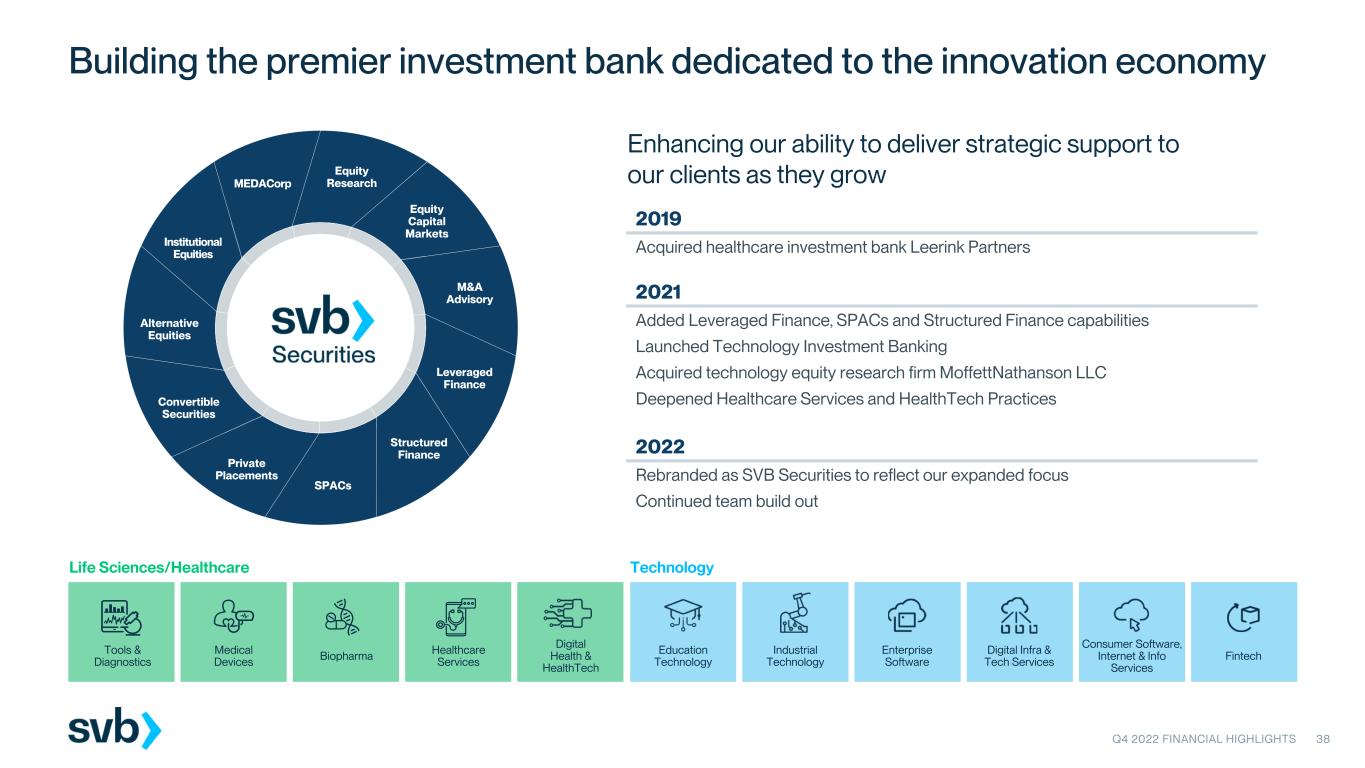
Technology Education Technology Industrial Technology Enterprise Software Digital Infra & Tech Services Consumer Software, Internet & Info Services Fintech Equity Capital Markets Convertible Securities Alternative Equities Institutional Equities MEDACorp M&A Advisory Equity Research Leveraged Finance Structured Finance SPACs Private Placements Building the premier investment bank dedicated to the innovation economy Life Sciences/Healthcare Tools & Diagnostics Medical Devices Biopharma Healthcare Services Digital Health & HealthTech Enhancing our ability to deliver strategic support to our clients as they grow Q4 2022 FINANCIAL HIGHLIGHTS 38 2019 Acquired healthcare investment bank Leerink Partners 2021 Added Leveraged Finance, SPACs and Structured Finance capabilities Launched Technology Investment Banking Acquired technology equity research firm MoffettNathanson LLC Deepened Healthcare Services and HealthTech Practices 2022 Rebranded as SVB Securities to reflect our expanded focus Continued team build out
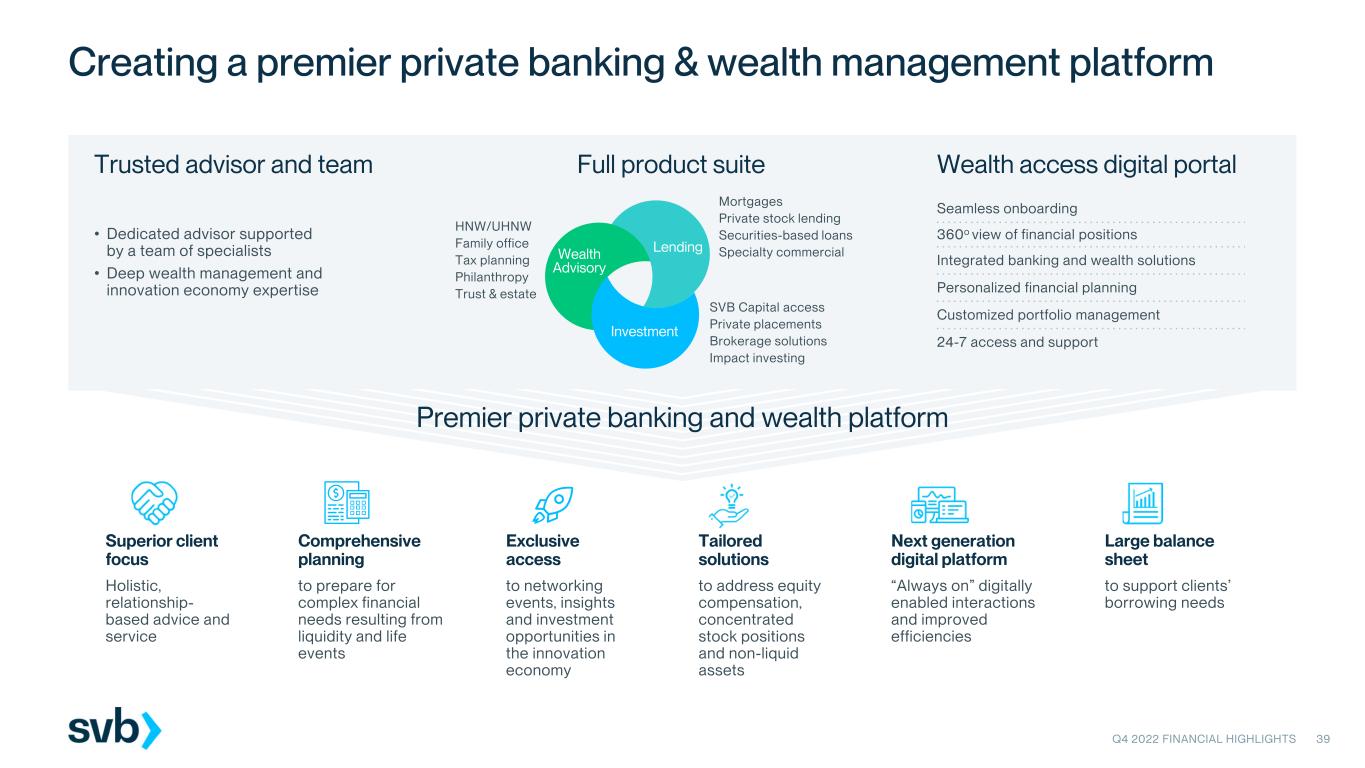
Wealth access digital portal Superior client focus Holistic, relationship- based advice and service Comprehensive planning to prepare for complex financial needs resulting from liquidity and life events Exclusive access to networking events, insights and investment opportunities in the innovation economy Tailored solutions to address equity compensation, concentrated stock positions and non-liquid assets Next generation digital platform “Always on” digitally enabled interactions and improved efficiencies Large balance sheet to support clients’ borrowing needs Wealth Advisory Investment Lending Creating a premier private banking & wealth management platform • Dedicated advisor supported by a team of specialists • Deep wealth management and innovation economy expertise Seamless onboarding 360o view of financial positions Integrated banking and wealth solutions Personalized financial planning Customized portfolio management 24-7 access and support Mortgages Private stock lending Securities-based loans Specialty commercial SVB Capital access Private placements Brokerage solutions Impact investing HNW/UHNW Family office Tax planning Philanthropy Trust & estate Premier private banking and wealth platform Trusted advisor and team Full product suite Q4 2022 FINANCIAL HIGHLIGHTS 39
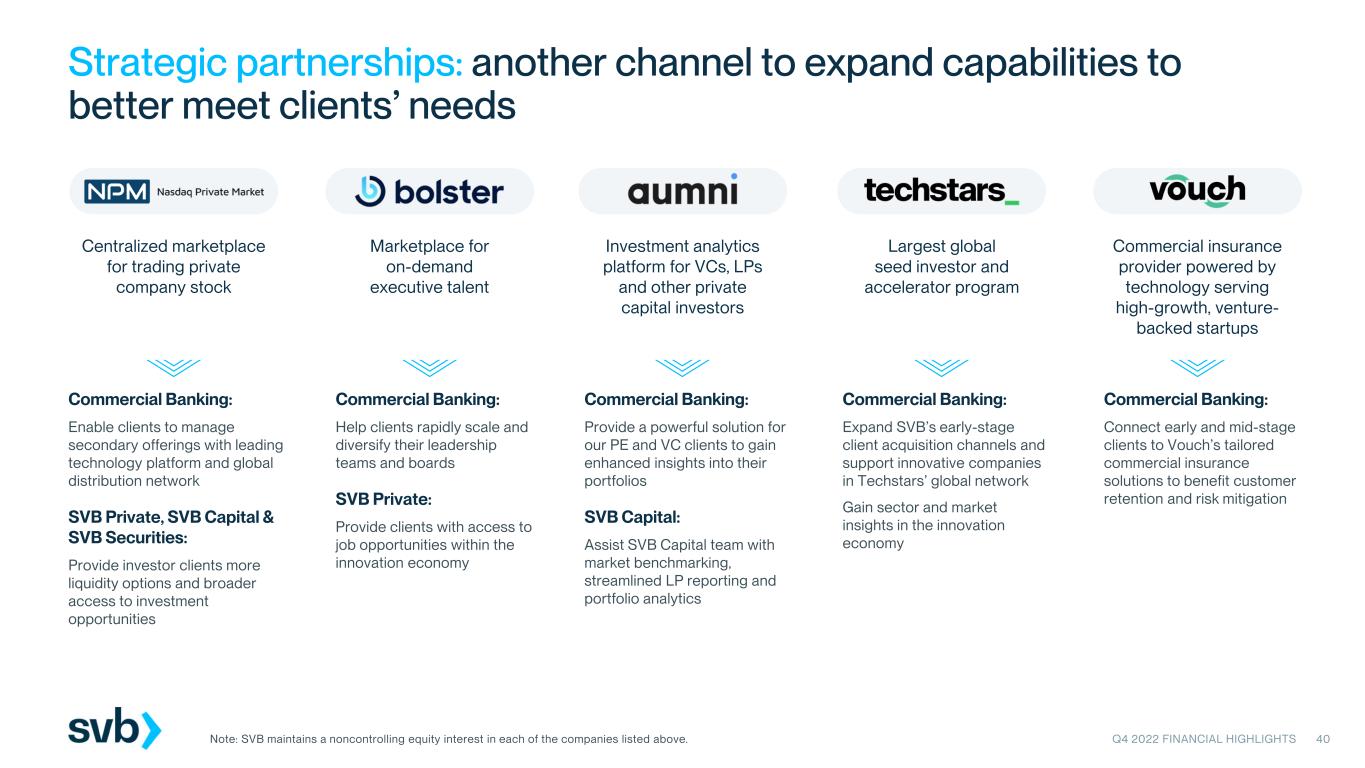
Centralized marketplace for trading private company stock Commercial Banking: Enable clients to manage secondary offerings with leading technology platform and global distribution network SVB Private, SVB Capital & SVB Securities: Provide investor clients more liquidity options and broader access to investment opportunities Marketplace for on-demand executive talent Commercial Banking: Help clients rapidly scale and diversify their leadership teams and boards SVB Private: Provide clients with access to job opportunities within the innovation economy Investment analytics platform for VCs, LPs and other private capital investors Commercial Banking: Provide a powerful solution for our PE and VC clients to gain enhanced insights into their portfolios SVB Capital: Assist SVB Capital team with market benchmarking, streamlined LP reporting and portfolio analytics Commercial insurance provider powered by technology serving high-growth, venture- backed startups Commercial Banking: Connect early and mid-stage clients to Vouch’s tailored commercial insurance solutions to benefit customer retention and risk mitigation Largest global seed investor and accelerator program Commercial Banking: Expand SVB’s early-stage client acquisition channels and support innovative companies in Techstars’ global network Gain sector and market insights in the innovation economy Strategic partnerships: another channel to expand capabilities to better meet clients’ needs Note: SVB maintains a noncontrolling equity interest in each of the companies listed above. Q4 2022 FINANCIAL HIGHLIGHTS 40
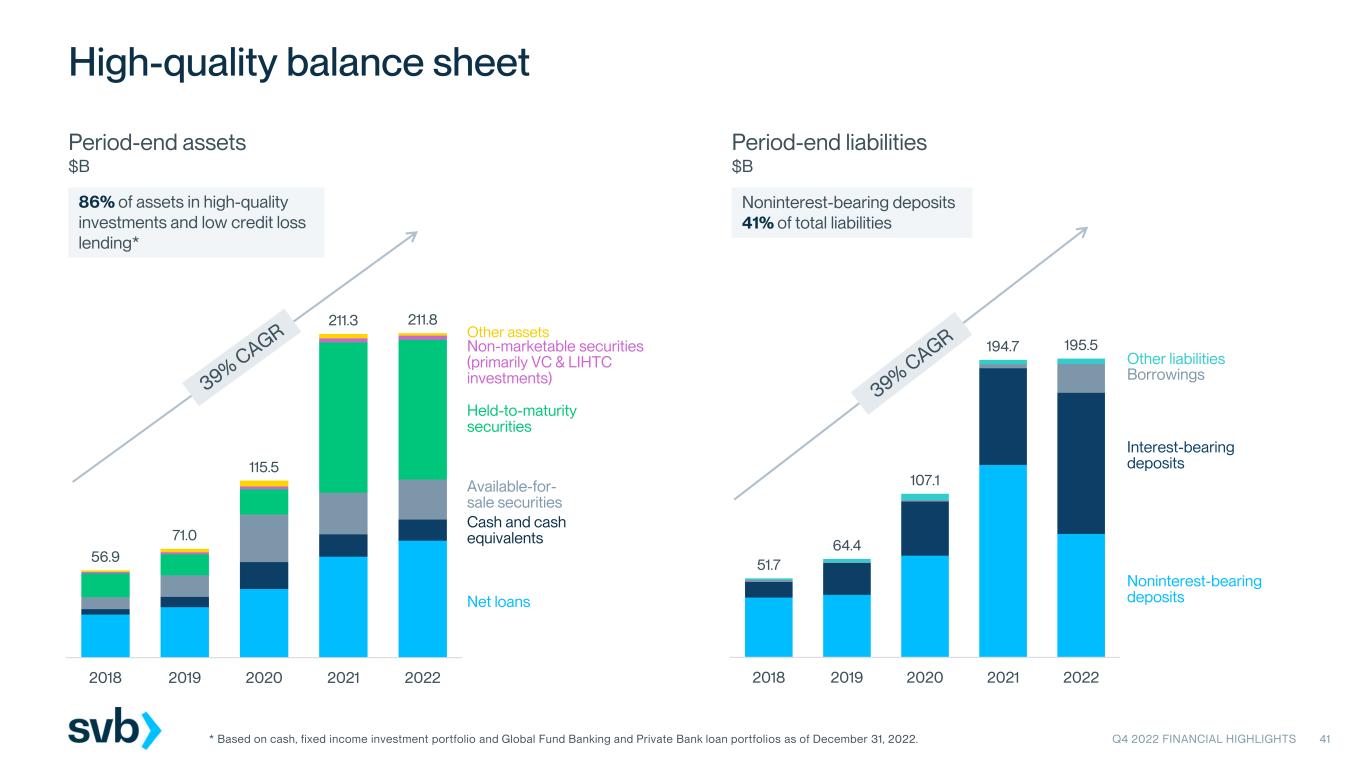
56.9 71.0 115.5 211.3 211.8 -$10 $10 $30 $50 $70 $90 $110 $130 $150 $170 $190 $210 $230 $250 2018 2019 2020 2021 2022 Period-end assets $B Period-end liabilities $B 51.7 64.4 107.1 194.7 195.5 $ $20 $40 $60 $80 $100 $120 $140 $160 $180 $200 $220 2018 2019 2020 2021 2022 High-quality balance sheet Noninterest-bearing deposits Borrowings Interest-bearing deposits Other liabilities Net loans Other assets Non-marketable securities (primarily VC & LIHTC investments) Held-to-maturity securities Available-for- sale securities Cash and cash equivalents * Based on cash, fixed income investment portfolio and Global Fund Banking and Private Bank loan portfolios as of December 31, 2022. 86% of assets in high-quality investments and low credit loss lending* Noninterest-bearing deposits 41% of total liabilities Q4 2022 FINANCIAL HIGHLIGHTS 41
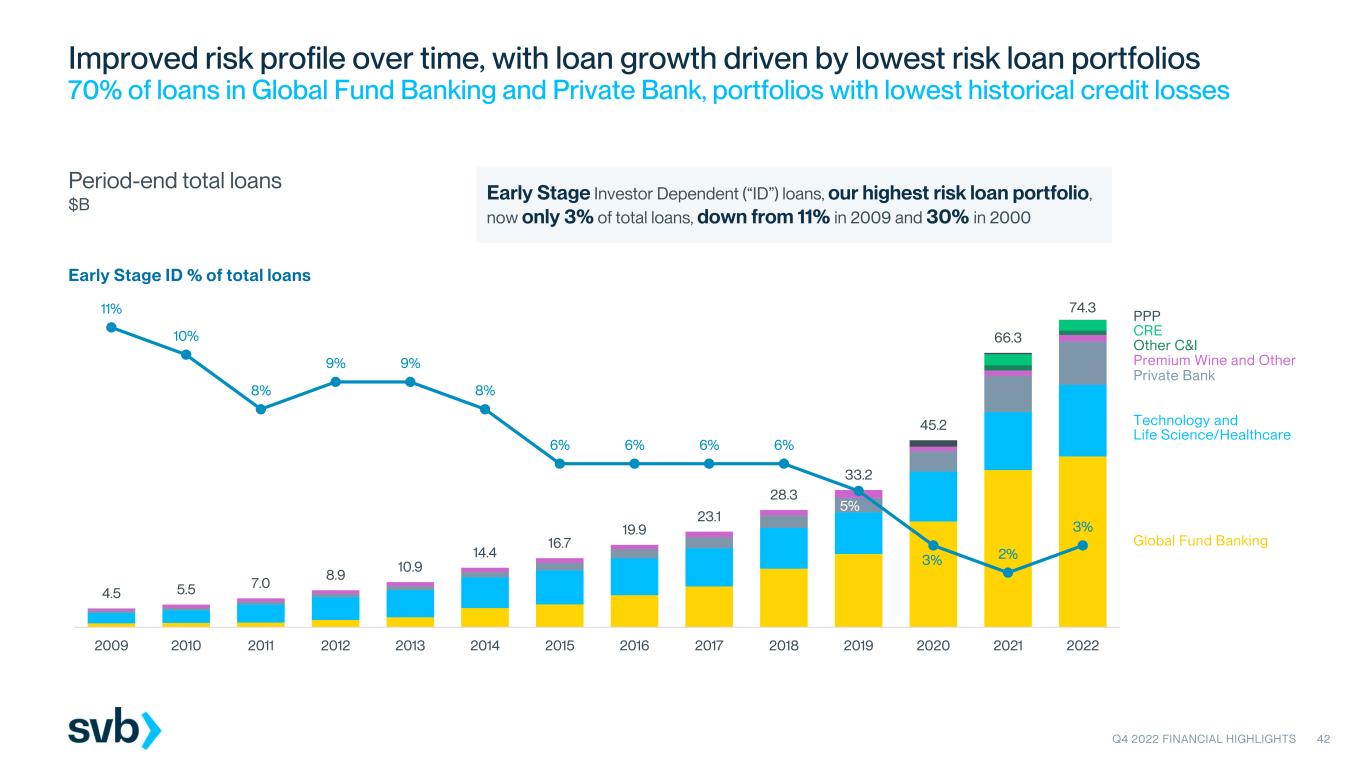
Improved risk profile over time, with loan growth driven by lowest risk loan portfolios 70% of loans in Global Fund Banking and Private Bank, portfolios with lowest historical credit losses Early Stage ID % of total loans Other C&I Technology and Life Science/Healthcare Premium Wine and Other Private Bank Global Fund Banking Early Stage Investor Dependent (“ID”) loans, our highest risk loan portfolio, now only 3% of total loans, down from 11% in 2009 and 30% in 2000 CRE PPP 4.5 5.5 7.0 8.9 10.9 14.4 16.7 19.9 23.1 28.3 33.2 45.2 66.3 74.311% 10% 8% 9% 9% 8% 6% 6% 6% 6% 5% 3% 2% 3% 2009 2010 2011 2012 2013 2014 2015 2016 2017 2018 2019 2020 2021 2022 Period-end total loans $B Q4 2022 FINANCIAL HIGHLIGHTS 42
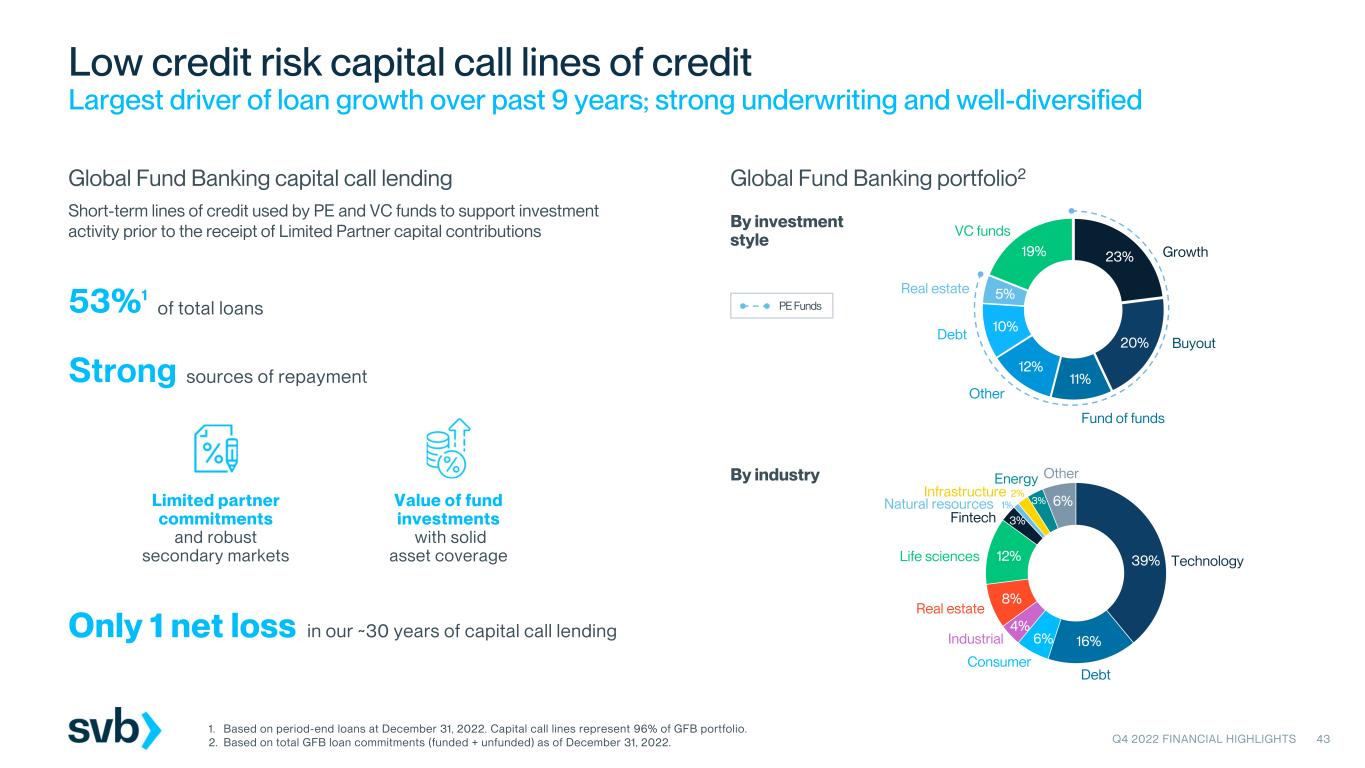
Low credit risk capital call lines of credit Largest driver of loan growth over past 9 years; strong underwriting and well-diversified 1. Based on period-end loans at December 31, 2022. Capital call lines represent 96% of GFB portfolio. 2. Based on total GFB loan commitments (funded + unfunded) as of December 31, 2022. Global Fund Banking capital call lending Short-term lines of credit used by PE and VC funds to support investment activity prior to the receipt of Limited Partner capital contributions of total loans53%1 Limited partner commitments and robust secondary markets Value of fund investments with solid asset coverage Strong sources of repayment Only 1 net loss in our ~30 years of capital call lending Global Fund Banking portfolio2 By industry By investment style 23% 20% 11% 12% 10% 5% 19% Debt Buyout Growth Fund of funds VC funds Other Real estate 39% 16%6% 4% 8% 12% 3% 1% 2% 3% 6% Life sciences Industrial Other Consumer Debt Technology Real estate Fintech Natural resources Infrastructure Energy PE Funds Q4 2022 FINANCIAL HIGHLIGHTS 43
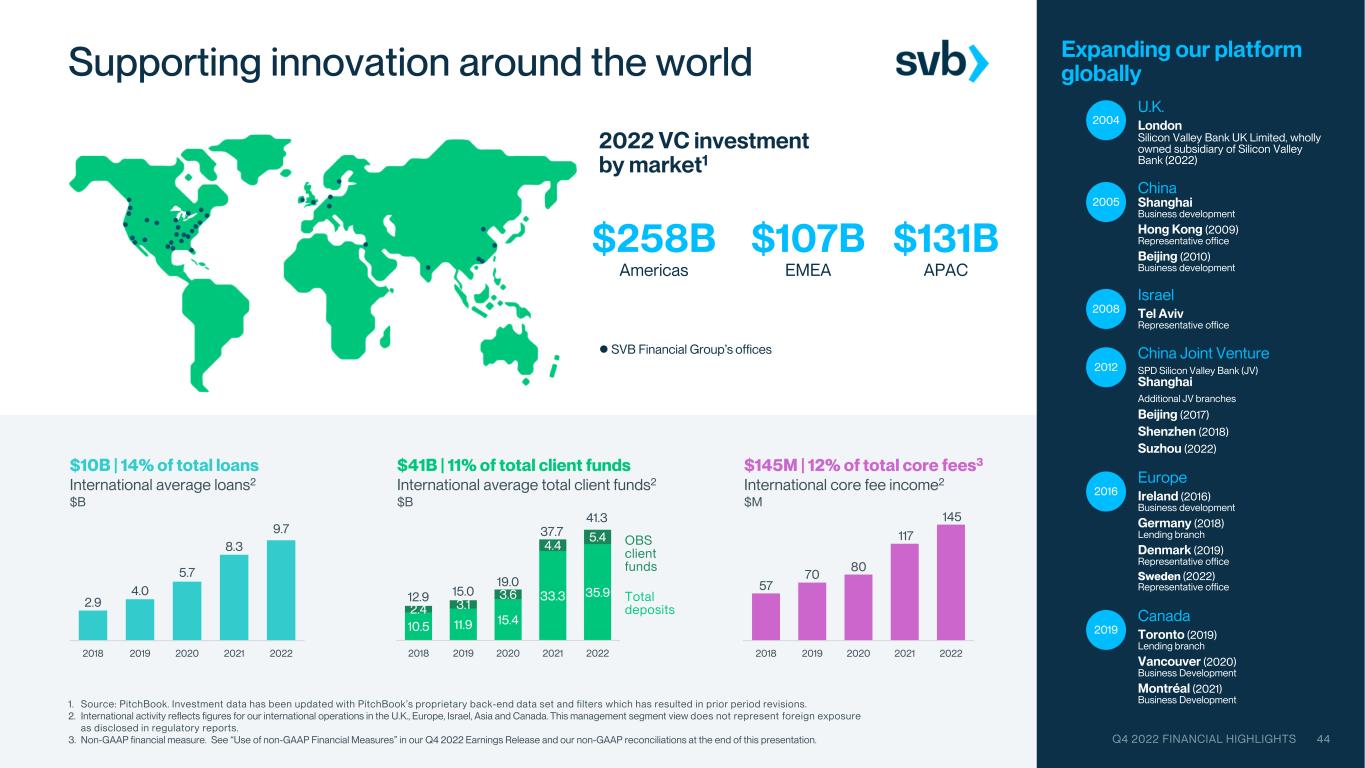
Supporting innovation around the world SVB Financial Group’s offices 1. Source: PitchBook. Investment data has been updated with PitchBook’s proprietary back-end data set and filters which has resulted in prior period revisions. 2. International activity reflects figures for our international operations in the U.K., Europe, Israel, Asia and Canada. This management segment view does not represent foreign exposure as disclosed in regulatory reports. 3. Non-GAAP financial measure. See “Use of non-GAAP Financial Measures” in our Q4 2022 Earnings Release and our non-GAAP reconciliations at the end of this presentation. $258B Americas $107B EMEA $131B APAC 2022 VC investment by market1 Expanding our platform globally 10.5 11.9 15.4 33.3 35.9 2.4 3.1 3.6 4.4 5.4 12.9 15.0 19.0 37.7 41.3 2018 2019 2020 2021 2022 Total deposits OBS client funds 57 70 80 117 145 2018 2019 2020 2021 2022 $10B | 14% of total loans International average loans2 $B 2.9 4.0 5.7 8.3 9.7 2018 2019 2020 2021 2022 $41B | 11% of total client funds International average total client funds2 $B $145M | 12% of total core fees3 International core fee income2 $M U.K. London Silicon Valley Bank UK Limited, wholly owned subsidiary of Silicon Valley Bank (2022) 2004 China Shanghai Business development Hong Kong (2009) Representative office Beijing (2010) Business development 2005 Israel Tel Aviv Representative office 2008 China Joint Venture SPD Silicon Valley Bank (JV) Shanghai Additional JV branches Beijing (2017) Shenzhen (2018) Suzhou (2022) 2012 Europe Ireland (2016) Business development Germany (2018) Lending branch Denmark (2019) Representative office Sweden (2022) Representative office 2016 Canada Toronto (2019) Lending branch Vancouver (2020) Business Development Montréal (2021) Business Development 2019 Q4 2022 FINANCIAL HIGHLIGHTS 44

11.1% 10.5% 11.2% 10.9% 12.4% 20.6% 20.0% 16.8% 17.1% 12.1% 9.0% 9.0% 8.2% 8.8% 9.8% 12.8% 11.8% 8.3% 13.2% 13.3% 0.0% 5.0% 10.0% 15.0% 20.0% 25.0% 30.0% 2013 2014 2015 2016 2017 2018 2019 2020 2021 2022 SVB Peer Average History of industry-leading performance 1/1/13 1/1/14 1/1/15 1/1/16 1/1/17 1/1/18 1/1/19 1/1/20 1/1/21 1/1/22 SVB 4.1x BKX 2.0x S&P 500 2.7x Total shareholder return2 Since 1/1/13 12/31/22 1. Source: S&P Global Market Intelligence or peer publicly reported earnings results. “Peers” refers to peer group as reported in our Proxy Statement for each year and is subject to change annually. 2022 average peer ROE includes 8 of 16 peers as of January 19, 2023. 2. Cumulative total return on $100 invested on 1/1/13 in stock or index. Includes reinvestment of dividends. Return on equity Strong total shareholder return As of 12/31/22: 1 Strong return on equity Q4 2022 FINANCIAL HIGHLIGHTS 45
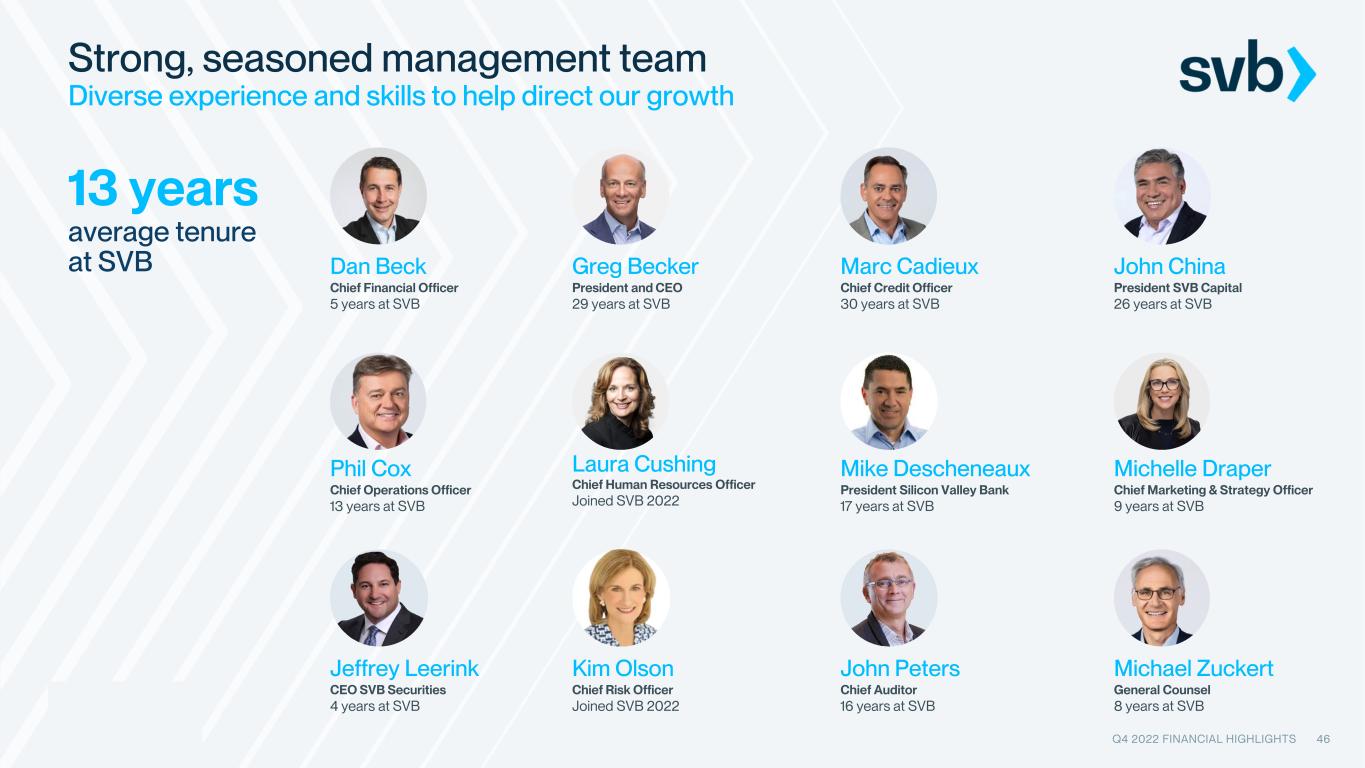
Strong, seasoned management team Diverse experience and skills to help direct our growth Q4 2022 FINANCIAL HIGHLIGHTS 46 Dan Beck Chief Financial Officer 5 years at SVB Greg Becker President and CEO 29 years at SVB Marc Cadieux Chief Credit Officer 30 years at SVB John China President SVB Capital 26 years at SVB Phil Cox Chief Operations Officer 13 years at SVB Mike Descheneaux President Silicon Valley Bank 17 years at SVB Michelle Draper Chief Marketing & Strategy Officer 9 years at SVB Jeffrey Leerink CEO SVB Securities 4 years at SVB John Peters Chief Auditor 16 years at SVB Michael Zuckert General Counsel 8 years at SVB Laura Cushing Chief Human Resources Officer Joined SVB 2022 Kim Olson Chief Risk Officer Joined SVB 2022 13 years average tenure at SVB
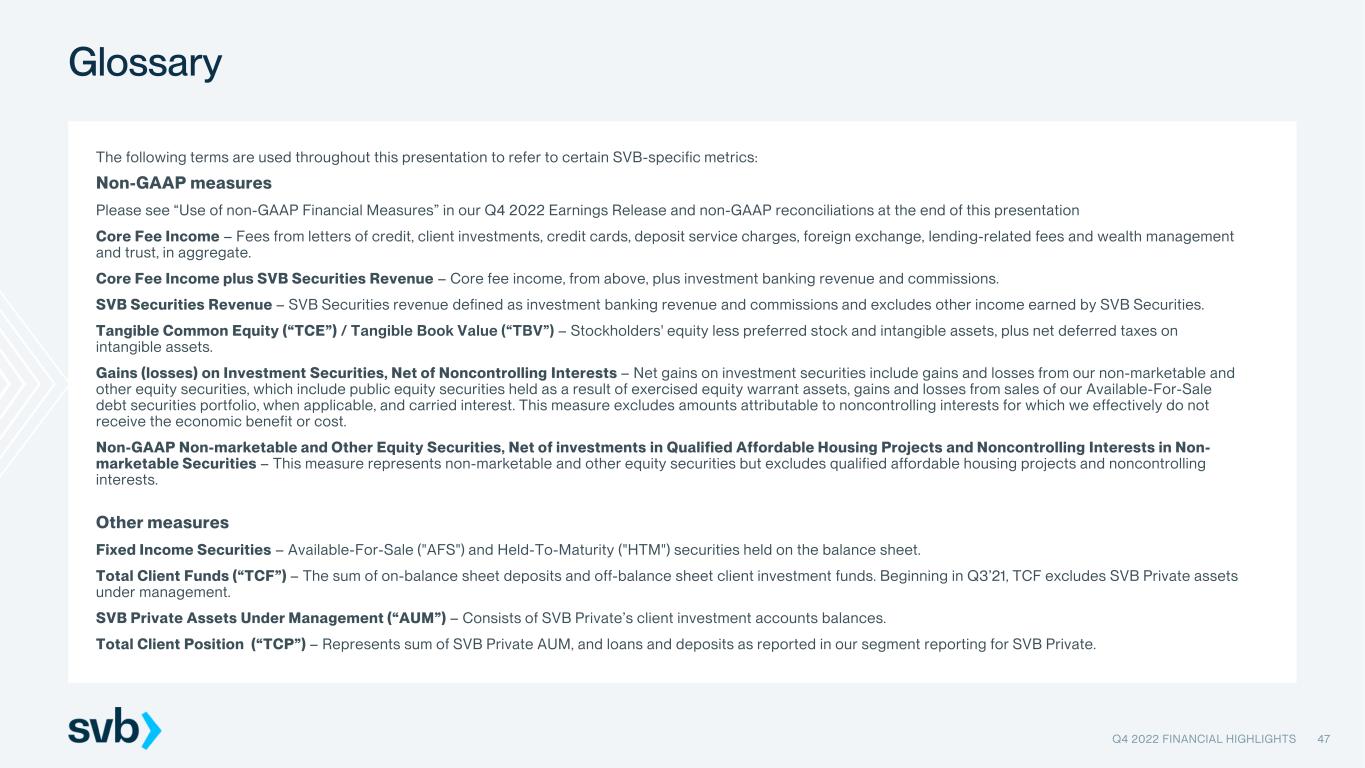
Glossary The following terms are used throughout this presentation to refer to certain SVB-specific metrics: Non-GAAP measures Please see “Use of non-GAAP Financial Measures” in our Q4 2022 Earnings Release and non-GAAP reconciliations at the end of this presentation Core Fee Income – Fees from letters of credit, client investments, credit cards, deposit service charges, foreign exchange, lending-related fees and wealth management and trust, in aggregate. Core Fee Income plus SVB Securities Revenue – Core fee income, from above, plus investment banking revenue and commissions. SVB Securities Revenue – SVB Securities revenue defined as investment banking revenue and commissions and excludes other income earned by SVB Securities. Tangible Common Equity (“TCE”) / Tangible Book Value (“TBV”) – Stockholders' equity less preferred stock and intangible assets, plus net deferred taxes on intangible assets. Gains (losses) on Investment Securities, Net of Noncontrolling Interests – Net gains on investment securities include gains and losses from our non-marketable and other equity securities, which include public equity securities held as a result of exercised equity warrant assets, gains and losses from sales of our Available-For-Sale debt securities portfolio, when applicable, and carried interest. This measure excludes amounts attributable to noncontrolling interests for which we effectively do not receive the economic benefit or cost. Non-GAAP Non-marketable and Other Equity Securities, Net of investments in Qualified Affordable Housing Projects and Noncontrolling Interests in Non- marketable Securities – This measure represents non-marketable and other equity securities but excludes qualified affordable housing projects and noncontrolling interests. Other measures Fixed Income Securities – Available-For-Sale ("AFS") and Held-To-Maturity ("HTM") securities held on the balance sheet. Total Client Funds (“TCF”) – The sum of on-balance sheet deposits and off-balance sheet client investment funds. Beginning in Q3’21, TCF excludes SVB Private assets under management. SVB Private Assets Under Management (“AUM”) – Consists of SVB Private’s client investment accounts balances. Total Client Position (“TCP”) – Represents sum of SVB Private AUM, and loans and deposits as reported in our segment reporting for SVB Private. Q4 2022 FINANCIAL HIGHLIGHTS 47
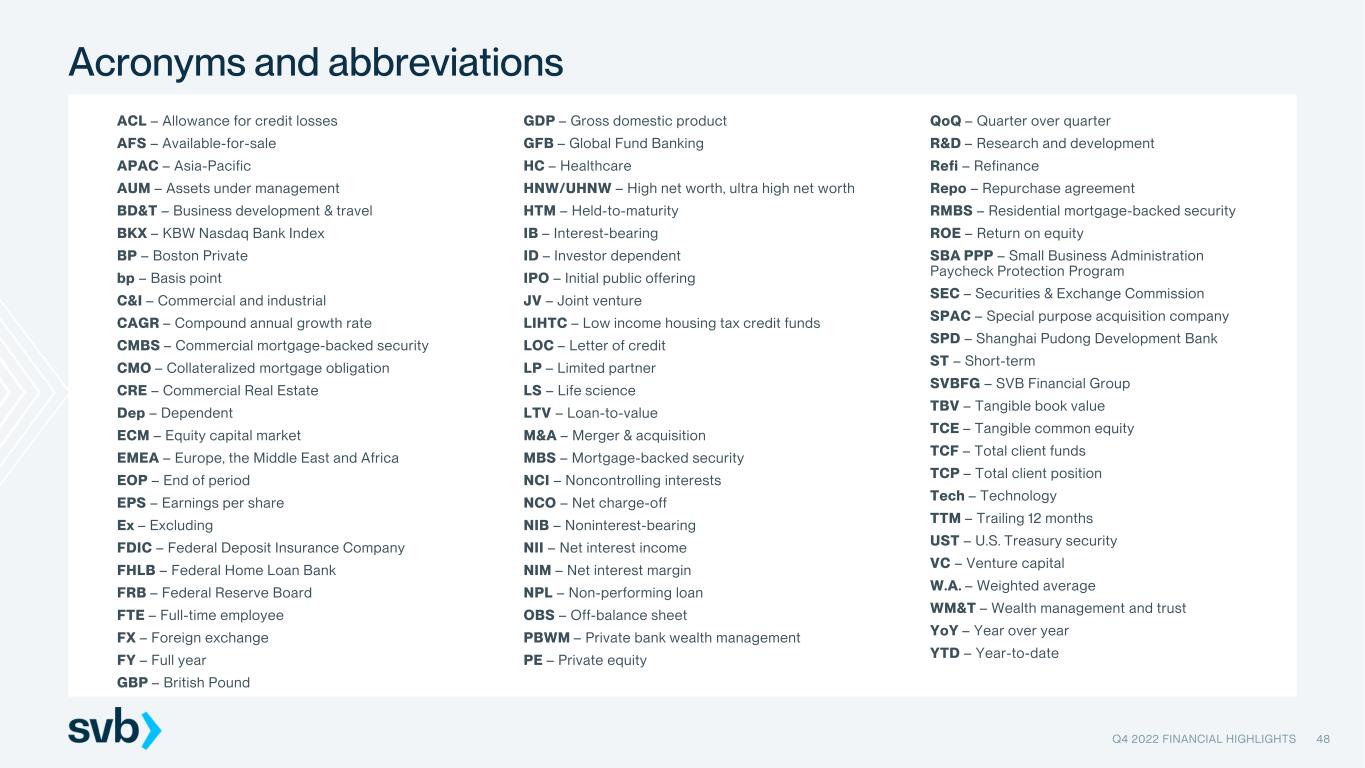
Acronyms and abbreviations GDP – Gross domestic product GFB – Global Fund Banking HC – Healthcare HNW/UHNW – High net worth, ultra high net worth HTM – Held-to-maturity IB – Interest-bearing ID – Investor dependent IPO – Initial public offering JV – Joint venture LIHTC – Low income housing tax credit funds LOC – Letter of credit LP – Limited partner LS – Life science LTV – Loan-to-value M&A – Merger & acquisition MBS – Mortgage-backed security NCI – Noncontrolling interests NCO – Net charge-off NIB – Noninterest-bearing NII – Net interest income NIM – Net interest margin NPL – Non-performing loan OBS – Off-balance sheet PBWM – Private bank wealth management PE – Private equity ACL – Allowance for credit losses AFS – Available-for-sale APAC – Asia-Pacific AUM – Assets under management BD&T – Business development & travel BKX – KBW Nasdaq Bank Index BP – Boston Private bp – Basis point C&I – Commercial and industrial CAGR – Compound annual growth rate CMBS – Commercial mortgage-backed security CMO – Collateralized mortgage obligation CRE – Commercial Real Estate Dep – Dependent ECM – Equity capital market EMEA – Europe, the Middle East and Africa EOP – End of period EPS – Earnings per share Ex – Excluding FDIC – Federal Deposit Insurance Company FHLB – Federal Home Loan Bank FRB – Federal Reserve Board FTE – Full-time employee FX – Foreign exchange FY – Full year GBP – British Pound QoQ – Quarter over quarter R&D – Research and development Refi – Refinance Repo – Repurchase agreement RMBS – Residential mortgage-backed security ROE – Return on equity SBA PPP – Small Business Administration Paycheck Protection Program SEC – Securities & Exchange Commission SPAC – Special purpose acquisition company SPD – Shanghai Pudong Development Bank ST – Short-term SVBFG – SVB Financial Group TBV – Tangible book value TCE – Tangible common equity TCF – Total client funds TCP – Total client position Tech – Technology TTM – Trailing 12 months UST – U.S. Treasury security VC – Venture capital W.A. – Weighted average WM&T – Wealth management and trust YoY – Year over year YTD – Year-to-date Q4 2022 FINANCIAL HIGHLIGHTS 48

Non-GAAP reconciliations Q4 2022 FINANCIAL HIGHLIGHTS 49

Non-GAAP reconciliation Core fee income and investment gains, net of NCI Non-GAAP core fee income (dollars in millions) Yea ear ended December 31, r 2018 2019 2020 2021 2022 GAAP noninterest income 745 1,221 1,840 2,738 1,728 Less: gains (loss) on investment securities, net 88 135 421 761 (285)* Less: net gains on equity warrant assets 89 138 237 560 148 Less: other noninterest income 52 55 98 128 166 Non-GAAP core fee income plus SVB Securities revenue 516 893 1,084 1,289 1,699 Investment banking revenue — 195 414 459 420 Commissions — 56 67 79 98 Less: total non-GAAP SVB Securities revenue — 251 481 538 518 Non-GAAP core fee income 516 642 603 751 1,181 See “Use of non-GAAP Financial Measures” in our Q4 2022 Earnings Release for more information. *Primarily driven by non-marketable and other equity securities. Non-GAAP net gains on investment securities, net on noncontrolling interests (dollars in millions) Year ended December 31, 2018 2019 2020 2021 2022 GAAP net gains (loss) on investment securities 88 135 421 761 (285)* Less: income (loss) attributable to noncontrolling interests, including carried interest allocation 38 48 86 240 (62) Non-GAAP net gains on investment securities, net of noncontrolling interests 50 87 335 521 (223) Q4 2022 FINANCIAL HIGHLIGHTS 50
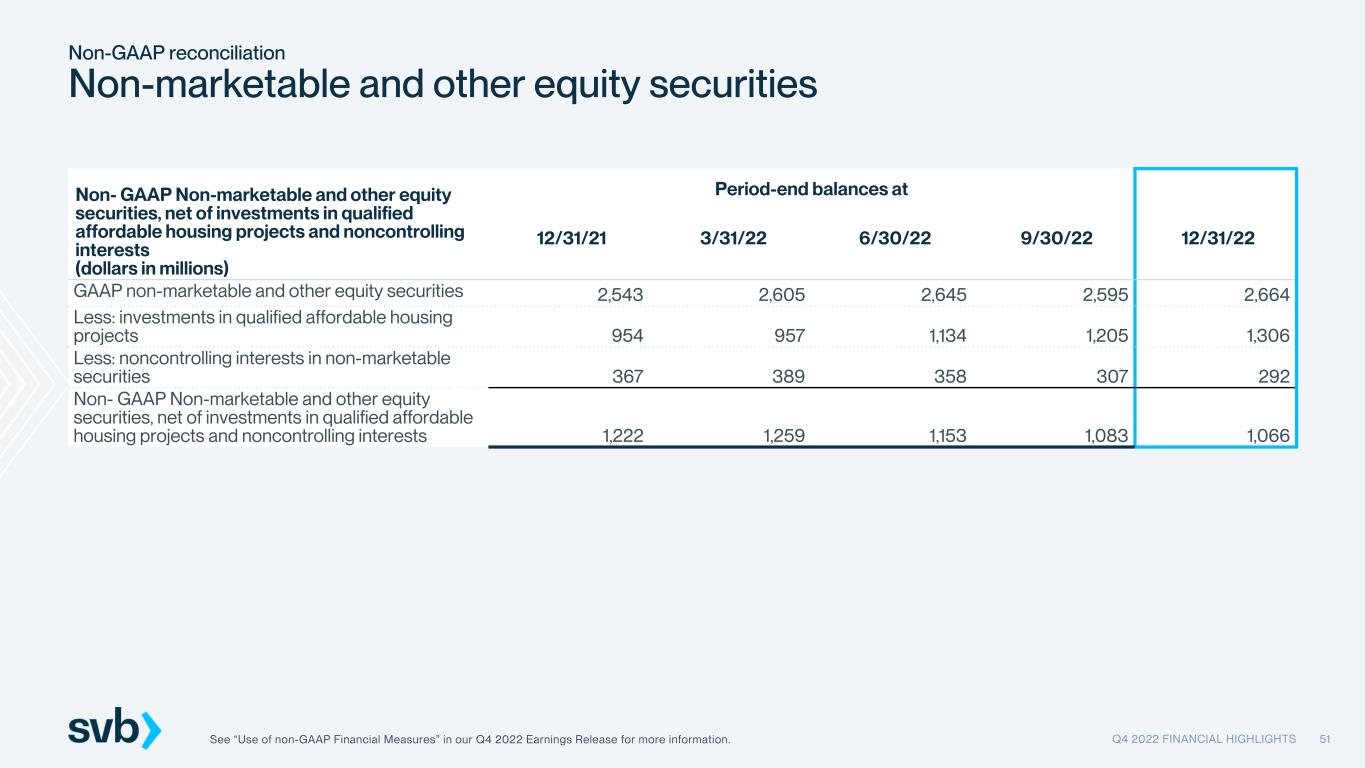
Non-GAAP reconciliation Non-marketable and other equity securities Non- GAAP Non-marketable and other equity securities, net of investments in qualified affordable housing projects and noncontrolling interests (dollars in millions) Period-end balances at 12/31/21 3/31/22 6/30/22 9/30/22 12/31/22 GAAP non-marketable and other equity securities 2,543 2,605 2,645 2,595 2,664 Less: investments in qualified affordable housing projects 954 957 1,134 1,205 1,306 Less: noncontrolling interests in non-marketable securities 367 389 358 307 292 Non- GAAP Non-marketable and other equity securities, net of investments in qualified affordable housing projects and noncontrolling interests 1,222 1,259 1,153 1,083 1,066 See “Use of non-GAAP Financial Measures” in our Q4 2022 Earnings Release for more information. Q4 2022 FINANCIAL HIGHLIGHTS 51

Important information regarding forward-looking statements and use of non-GAAP financial measures The Company’s financial results for 2022 reflected in this presentation are unaudited. This document should be read in conjunction with the Company’s SEC filings. Forward-Looking Statements This presentation contains forward-looking statements within the meaning of the safe harbor provisions of the Private Securities Litigation Reform Act of 1995. Forward-looking statements are subject to known and unknown risks and uncertainties, many of which may be beyond our control. Forward-looking statements are statements that are not historical facts, such as forecasts of our future financial results and condition, expectations for our operations and business, and our underlying assumptions of such forecasts and expectations. In addition, forward-looking statements generally can be identified by the use of such words as “becoming,” “may,” “will,” “should,” “could,” “would,” “predict,” “potential,” “continue,” “anticipate,” “believe,” “estimate,” “assume,” “seek,” “expect,” “plan,” “intend,” the negative of such words or comparable terminology. In this presentation, we make forward-looking statements discussing management’s expectations for 2023 and the first quarter of 2023 about, among other things, economic conditions; the continuing and potential effects of the COVID-19 pandemic; opportunities in the market; our commitments and objectives in relation to sustainable finance and managing risks associated with climate change; the outlook on our clients' performance; our financial, credit, and business performance, including potential investment gains, loan and deposit growth, mix and yields/rates, and expense levels; our expected effective tax rate; the interest rate environment; accounting impacts and financial results (and the components of such results). Although we believe that the expectations reflected in our forward-looking statements are reasonable, we have based these expectations on our current beliefs as well as our assumptions, and such expectations may not prove to be correct. Because forward-looking statements relate to the future, they are subject to inherent uncertainties, risks and changes in circumstances that are difficult to predict and many of which are outside our control. Our actual results of operations and financial performance could differ significantly from those expressed in or implied by our management’s forward-looking statements. Important factors that could cause our actual results and financial condition to differ from the expectations stated in the forward-looking statements include, among others: market and economic conditions (including elevated inflation levels, sustained interest rate increases, the general condition of the capital and equity markets, and private equity and venture capital investment, IPO, secondary offering, SPAC fundraising, M&A and other financing activity levels) and the associated impact on us (including effects on total client funds and client demand for our commercial and investment banking and other financial services, as well as on the valuations of our investments); disruptions to the financial markets as a result of current or anticipated military conflicts, including the ongoing military conflict between Russia and Ukraine, terrorism and other geopolitical events; the COVID-19 pandemic, including COVID-19 variants and their effects on the economic and business environments in which we operate, and its effects on our business and operations; the impact of changes from the Biden-Harris administration and the U.S. Congress on the economic environment, capital markets and regulatory landscape, including monetary, tax and other trade policies, as well as regulatory changes from bank regulatory agencies; changes in the volume and credit quality of our loans as well as volatility of our levels of nonperforming assets and charge-offs; the impact of changes in interest rates or market levels or factors affecting or affected by them, including on our loan and investment portfolios and deposit costs; the adequacy of our allowance for credit losses and the need to make provisions for credit losses for any period; the sufficiency of our capital and liquidity positions, and our ability to generate capital or raise capital on favorable terms; changes in the levels or composition of our loans, deposits and client investment fund balances; changes in the performance or equity valuations of funds or companies in which we have invested or hold derivative instruments or equity warrant assets; variations from our expectations as to factors impacting our cost structure; changes in our assessment of the creditworthiness or liquidity of our clients or unanticipated effects of credit concentration risks which create or exacerbate deterioration of such creditworthiness or liquidity; variations from our expectations as to factors impacting the timing and level of employee share-based transactions; the occurrence of fraudulent activity, including breaches of our information security or cyber security-related incidents; business disruptions and interruptions due to natural disasters and other external events; the impact on our reputation and business from our interactions with business partners, counterparties, service providers and other third parties; the expansion of our business internationally, and the impact of geopolitical events and international market and economic events on us; the effectiveness of our risk management framework and quantitative models; unexpected delays or expenses associated with executing against our climate-related commitments and goals; the quality and availably of carbon emissions data; our ability to maintain or increase our market share, including through successfully implementing our business strategy and undertaking new business initiatives, including through the continuing integration of Boston Private, the expansion of SVB Private and the growth and expansion of SVB Securities; greater than expected costs or other difficulties related to the continuing integration of our business and that of Boston Private; variations from our expectations as to the amount and timing of business opportunities, growth prospects and cost savings associated with the acquisition of Boston Private; the inability to retain existing Boston Private clients and employees following the Boston Private acquisition; unfavorable resolution of legal proceedings or claims, as well as legal or regulatory proceedings or governmental actions; variations from our expectations as to factors impacting our estimate of our full-year effective tax rate; changes in applicable accounting standards and tax laws; and regulatory or legal changes (including changes to the laws and regulations that apply to us as a result of the growth of our business) and their impact on us. We refer you to the documents the Company files from time to time with the Securities and Exchange Commission, including (i) our latest Annual Report on Form 10-K, (ii) our most recent Quarterly Report on Form 10-Q, and (iii) our most recent earnings release filed on Form 8-K. These documents contain and identify important risk factors that could cause the Company’s actual results to differ materially from those contained in our projections or other forward-looking statements. All forward-looking statements included in this presentation are made only as of the date of this presentation. We assume no obligation and do not intend to revise or update any forward-looking statements contained in this presentation, except as required by law. This presentation shall not constitute an offer or solicitation in connection with any securities. Use of Non-GAAP Financial Measures To supplement our financial disclosures that are presented in accordance with GAAP, we use certain non-GAAP measures of financial performance (including, but not limited to, non-GAAP core fee income, non-GAAP SVB Securities revenue, non-GAAP core fee income plus non-GAAP SVB Securities revenue, non-GAAP net gains on investment securities, non-GAAP non-marketable and other equity securities net of investments in qualified affordable housing projects and noncontrolling interests in non-marketable securities, and non- GAAP financial ratios) of financial performance. These supplemental performance measures may vary from, and may not be comparable to, similarly titled measures by other companies in our industry. Non-GAAP financial measures are not in accordance with, or an alternative for, GAAP. Generally, a non-GAAP financial measure is a numerical measure of a company’s performance that either excludes or includes amounts that are not normally excluded or included in the most directly comparable measure calculated and presented in accordance with GAAP. A non-GAAP financial measure may also be a financial metric that is not required by GAAP or other applicable requirement. We believe that these non-GAAP financial measures, when taken together with the corresponding GAAP financial measures (as applicable), provide meaningful supplemental information regarding our performance by: (i) excluding amounts attributable to noncontrolling interests for which we effectively do not receive the economic benefit or cost of, where indicated, or (ii) providing additional information used by management that is not otherwise required by GAAP or other applicable requirements. Our management uses, and believes that investors benefit from referring to, these non-GAAP financial measures in assessing our operating results and when planning, forecasting and analyzing future periods. These non-GAAP financial measures also facilitate a comparison of our performance to prior periods. We believe these measures are frequently used by securities analysts, investors and other interested parties in the evaluation of companies in our industry. However, these non-GAAP financial measures should be considered in addition to, not as a substitute for or superior to, net income or other financial measures prepared in accordance with GAAP. Under the “Use of Non-GAAP Financial Measures” section in our latest earnings release attached as an exhibit to our Form 8-K on January 19, 2023, we have provided reconciliations of, where applicable, the most comparable GAAP financial measures to the non-GAAP financial measures used in this presentation, or a reconciliation of the non-GAAP calculation of the financial measure. Please refer to that section of the earnings release for more information. . Q4 2022 FINANCIAL HIGHLIGHTS 52
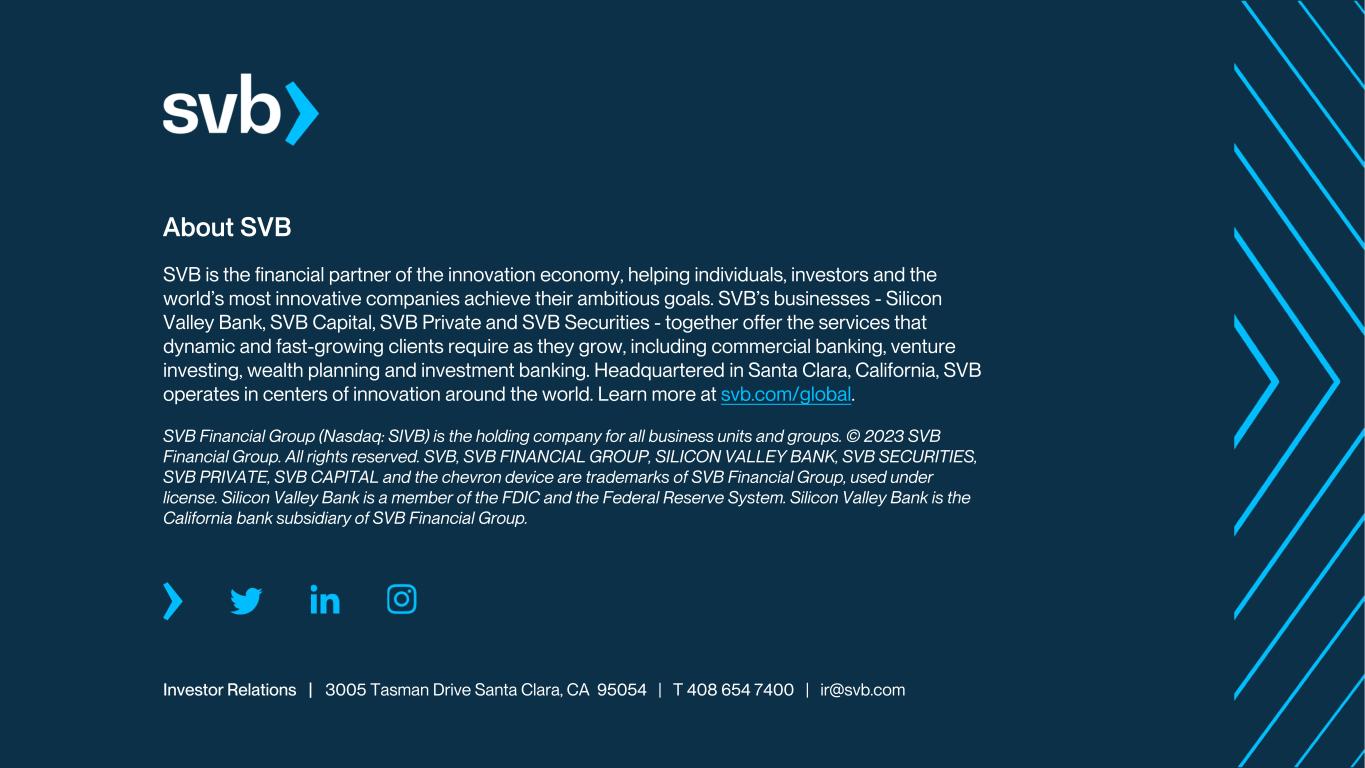
About SVB SVB is the financial partner of the innovation economy, helping individuals, investors and the world’s most innovative companies achieve their ambitious goals. SVB’s businesses - Silicon Valley Bank, SVB Capital, SVB Private and SVB Securities - together offer the services that dynamic and fast-growing clients require as they grow, including commercial banking, venture investing, wealth planning and investment banking. Headquartered in Santa Clara, California, SVB operates in centers of innovation around the world. Learn more at svb.com/global. SVB Financial Group (Nasdaq: SIVB) is the holding company for all business units and groups. © 2023 SVB Financial Group. All rights reserved. SVB, SVB FINANCIAL GROUP, SILICON VALLEY BANK, SVB SECURITIES, SVB PRIVATE, SVB CAPITAL and the chevron device are trademarks of SVB Financial Group, used under license. Silicon Valley Bank is a member of the FDIC and the Federal Reserve System. Silicon Valley Bank is the California bank subsidiary of SVB Financial Group. Investor Relations | 3005 Tasman Drive Santa Clara, CA 95054 | T 408 654 7400 | ir@svb.com
























































